Russia’s fossil fuel war economy drives oppression and climate breakdown
Greenpeace International
A new report – the most far-reaching analysis of environment and environmentalism in Russia since 2022 – shows how Putin’s regime relies on a toxic troika of extractivism, authoritarianism and war. Fossil fuels finance war. War justifies repression. Authoritarianism shields elites from scrutiny while blocking demands for justice. Its veil of disinformation, propaganda and control of information is now so thick that free reporting on Russia now depends on information gathered from outside its borders: the world’s largest country has become a void of reliable information. This cycle devastates nature, dismantles institutions, oppresses societies, and poses a systemic threat to global security and environmental stability. Russia’s unprovoked aggression against Ukraine is also a danger to the wider world – but, frighteningly, it can provoke other cases. Its hostility is a warning to the world of how far an authoritarian regime based on fossil fuel economy can go. Russia’s invasion of Ukraine sent shockwaves around the world. It has brought death, devastation and displacement to millions, triggered one of the largest refugee crises of the 21st century, and upended energy, trade, finance and food systems worldwide. Over three years since Russia’s full-scale assault in February 2022 – which itself came after eight years of illegal occupation of Crimea and parts of Donetsk and Luhansk – the consequences of Russia’s invasion continue to reverberate. Russia’s occupation and weaponisation of Ukraine’s nuclear power plants, including Europe’s largest, not only presents a chilling reminder of the Soviet era Chornobyl disaster that sent a cloud of radiation – and existential terror – as far away as North Africa and Canada. It also creates an unprecedented, more direct and more sinister threat to Europe and the wider world. Natural systems in such a large country as Russia have an enormous influence on global environmental and climate stability. Nearly half of Russia is forest, which, alongside vast tundra, wetlands and permafrost, stores immense carbon reserves and safeguards biodiversity (see chapter 4: Biodiversity Crisis). Forest loss could accelerate the climate crisis and trigger irreversible ecological damage but under Kremlin policy, these ecosystems risk losing resilience fast: over half of Russia’s forest is deemed exploitable; fires spread unchecked; permafrost thaws, and fragile habitats fragment. Meanwhile, the risks of environmental and technological disasters continue to grow. Corruption, ageing infrastructure and dismantled oversight systems make spills, leaks and industrial accidents more likely (see chapter 1: Socioeconomic Context). One doesn’t have to look far for an example: in December 2024, a disaster in the Black Sea, affecting the Russian coast as well as the coast of temporarily occupied Crimea, made headlines worldwide, when reportedly several thousand tons of heavy fuel oil spilled into the water after two tankers wrecked in a storm in the Kerch Strait. Thousands of volunteers rushed to clean the coastline and protect wildlife, while the authorities once again failed to deliver an adequate response to a disaster rooted in their fossil-fuel-dependent system. The Russian Arctic is now a militarised and ecologically vulnerable zone. Warming four times faster than the global average, it is under pressure from oil and gas drilling, military expansion, and the breakdown of international cooperation. Indigenous Peoples are being displaced from their land, their rights ignored and livelihoods destroyed. Beyond its borders, Russia exports its extractivist model. Through fossil fuel projects in Uganda, Egypt, Mozambique and beyond – and nuclear deals pushed by state nuclear corporation Rosatom, which is implicated in war crimes allegations at Ukraine’s Zaporizhzhia nuclear power plant – Russia locks countries into dependency while enriching elites. International actors remain complicit: many states and corporations continue buying Russian oil, gas and raw materials, sustaining war, repression and destruction. Greenpeace activists worldwide, however, continue to speak out boldly, urging their governments to sanction Russia’s shadow fleet and halt purchases of Russian fossil fuels. At global forums like G20 and BRICS+, Russia systematically obstructs and sabotages international cooperation, hiding behind “resource sovereignty” to weaken binding climate and biodiversity agreements. Many of its “green” organisations are state-controlled, while genuine environmental governance has collapsed into imitation initiatives and propaganda. The lesson for the world is stark: when countries promote reckless extractivism or elites profiteering from destruction, or let fossil fuels dominate their economies, they risk sliding into the same dangerous cycle. The erosion of democracy, the fog of propaganda, and the silencing of dissent go hand in hand with environmental collapse and vicious war-mongering. The Kremlin has cracked down on civil society, dismantling independent organisations and shrinking access to environmental information. Public oversight is almost impossible – but groundbreaking analysis like this proves reporting can cut through the silence. Moreover, it shows that environmental issues remain one of the few areas where ordinary Russians still find solidarity, even under severe constraints. Many organizations were forced to be closed, and many activists had to leave the home country. Those who remain tend to avoid confrontational topics, use coded language, and focus on expert reports, online petitions, or participation in state advisory councils. Local ecological protests, such as against landfills or industrial projects, continue and sometimes yield local victories, but systemic change is rare amidst the state intimidation. Greenpeace Russia was forcibly closed after 30 years of defending forests, rivers and communities. But repression has not silenced the movement. Twelve years ago, the Arctic 30 were arrested at gunpoint for peacefully protesting Arctic oil drilling. Their detention sparked a global outcry, and they were freed after three months. Russia was ordered to pay damages. The episode reminded the world of the power of solidarity, as people across the globe stood together to defend international activists risking their freedom to speak out for the planet. Today, grassroots resistance in Russia still connects with international allies, keeping alive the hope of a sustainable alternative. Russia holds enormous potential for a different path: vast renewable resources, rich biodiversity, scientific expertise and strong public concern for the environment. But unlocking that potential requires fundamental change: an end to aggressions, restoration of civil society, a shift away from extractivism towards sustainability and others. Even as Putin’s assault on civic space in Russia continues, the environment remains one of the few subjects where civic engagement persists — offering potential that, if nurtured, could contribute to broader shifts in Russian society. Russia is a warning for other countries whose government agenda depends on fossil fuel extraction, authoritarian rule and militarism. It is also a powerful reminder: without resistance there is no fair, green and peaceful future. But repression breeds resistance – and Greenpeace continues to bear witness and break the silence. Governments and powerful elites have tried to silence us before, by bombing our ship, suing Greenpeace entities, shutting down offices and attempting to erase our existence. It didn’t work then, and it won’t work now. Our movement is global. It is unstoppable.Solidarity fuels hope. Together, we can resist, rebuild and create a fairer, greener and more peaceful future. Tell Energy Transfer and other corporate bullies: Stop your attacks on free speech. Texte intégral (2634 mots)
A toxic troika of extractivism, authoritarianism and war
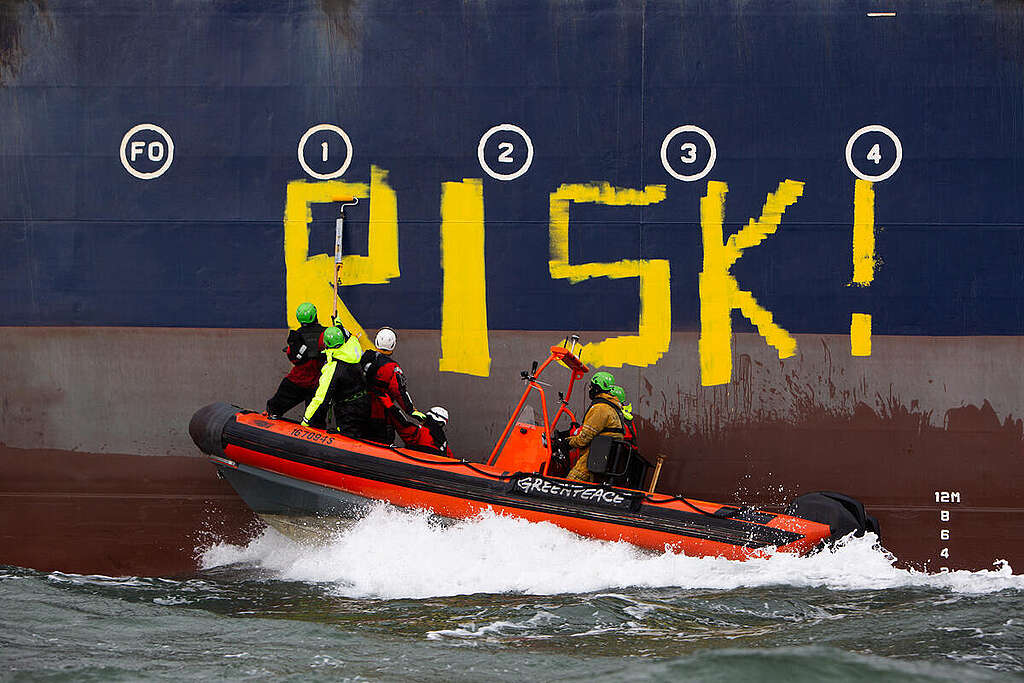
Russia’s aggression against Ukraine
From the Arctic to Africa: a global threat with global consequences
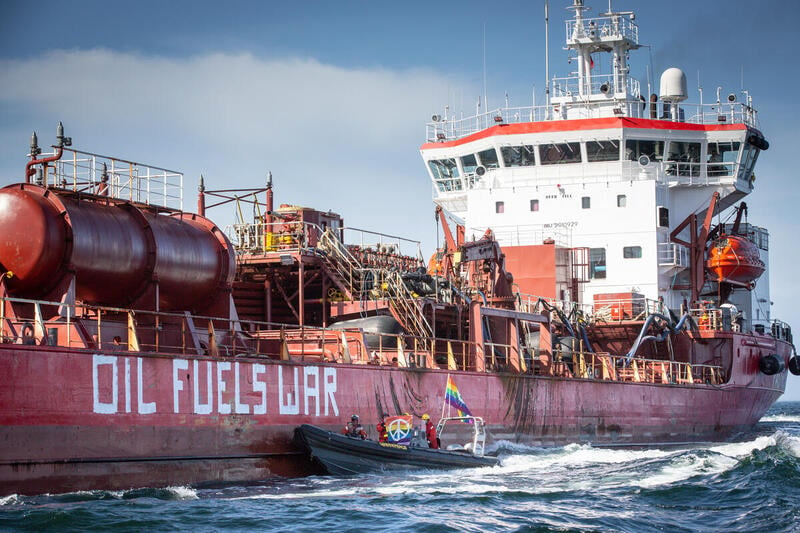
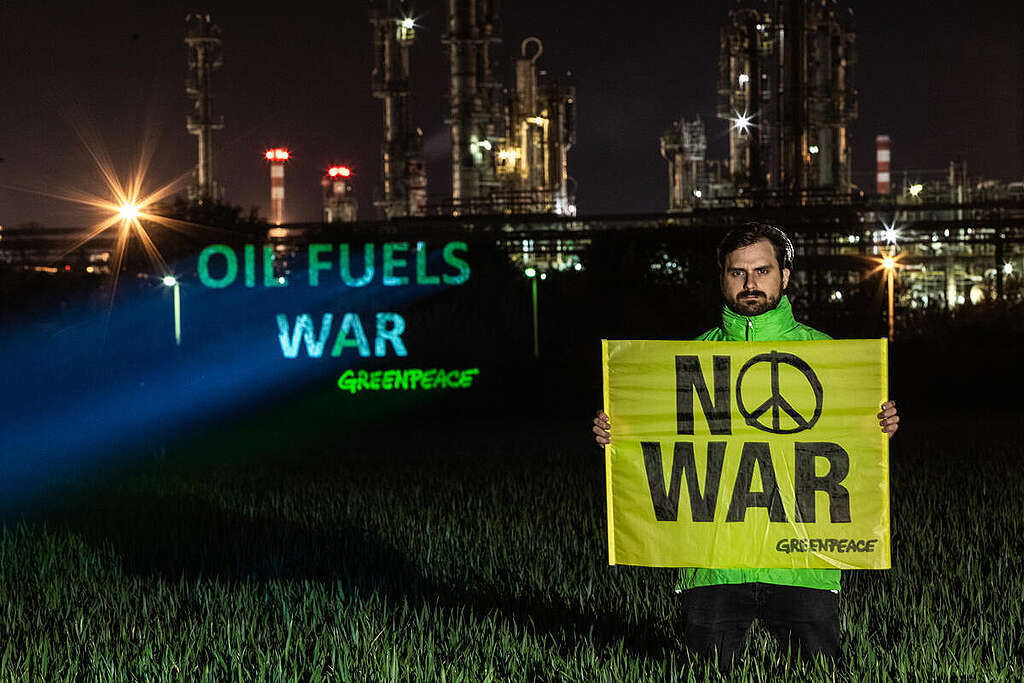
A warning to the world
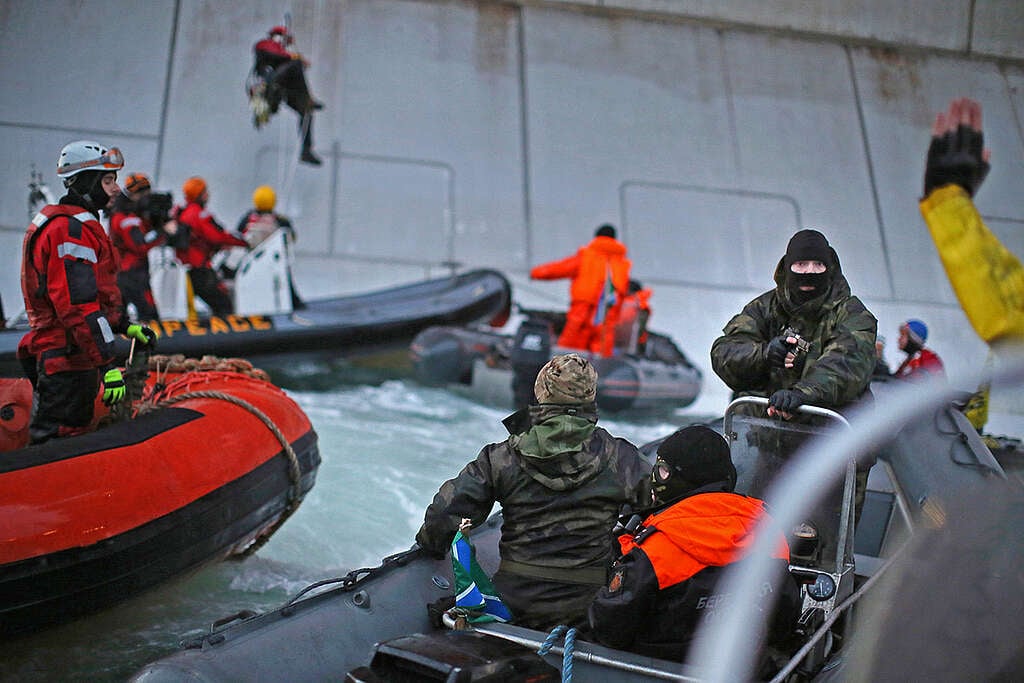
…as the hope for resistance endures, solidarity continues to grow
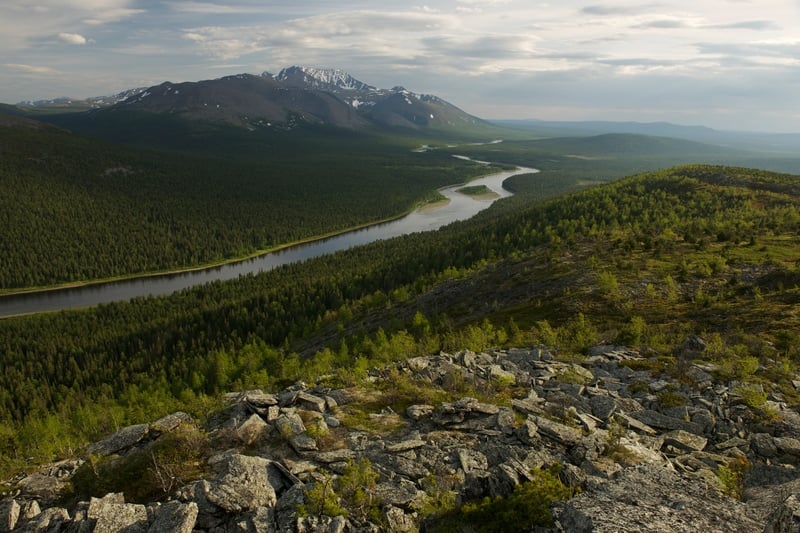
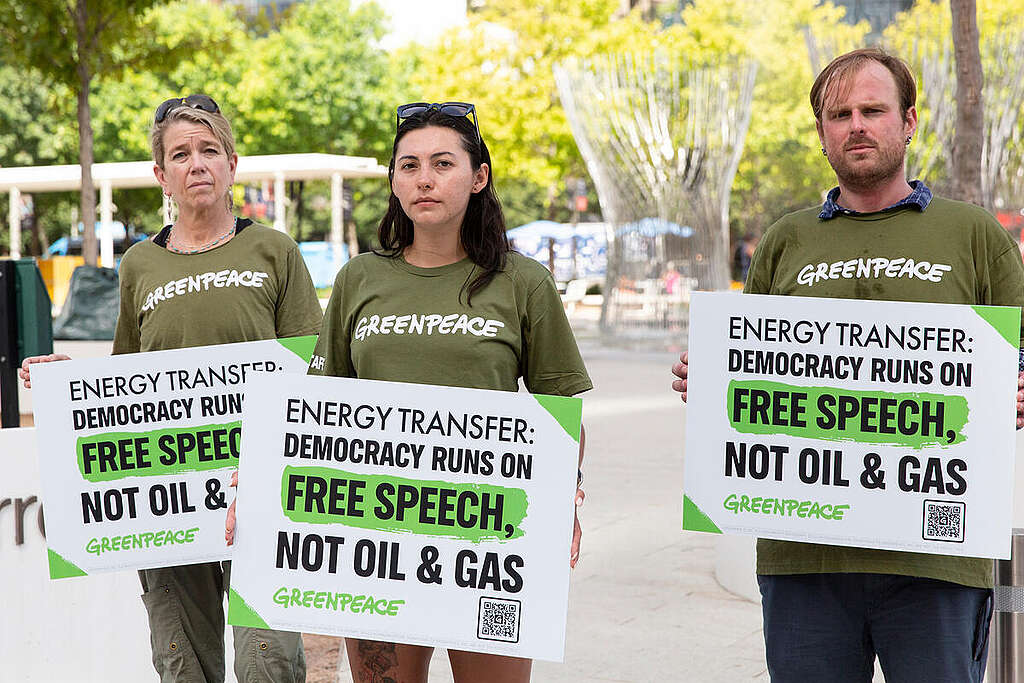
2025 in Images
Sudhanshu Malhotra
2025 has been yet another year marked by some serious climate emergencies. Throughout the year, we saw irregular weather patterns, back-to-back typhoons, torrential rains, flash floods, forest fires, and polar vortexes — all of which are exacerbated by the fossil fuel-caused climate crisis. These climate disasters have resulted to thousands of people dying, and millions being forced to leave their homes. This is the reality for so many people all around the world, many of whom have contributed the least amount of climate damage. But the stark contrast to these disasters are the images of courage and hope that we saw year-round: everyday folks rising up against all odds to take charge of their destiny, demanding a better future for all. People from different parts of the world, including Thailand, Sri Lanka, Mexico, Cameroon, Romania, Brazil, the Philippines, and Kenya, have chosen to seek solutions and demand reparations from polluters who have long taken advantage of natural resources, people’s livelihoods, and our collective future. The resilience, bravery, and hope of these people have been the most inspiring, and will fuel the future where we will no longer be taken for granted by the billionaires who only seek to achieve personal gain. Overwhelmed by the sheer volume of images this year, below is a small selection of the most inspiring images of 2025. Texte intégral (8418 mots)
These images fill us with the promise that 2026 will be a continuation of people power; of standing up for our rights and for the next generations. They are a reminder that we need to hold governments and polluting corporations accountable — and that we need the systems to shift towards an equitable and just world where everyone is winning. 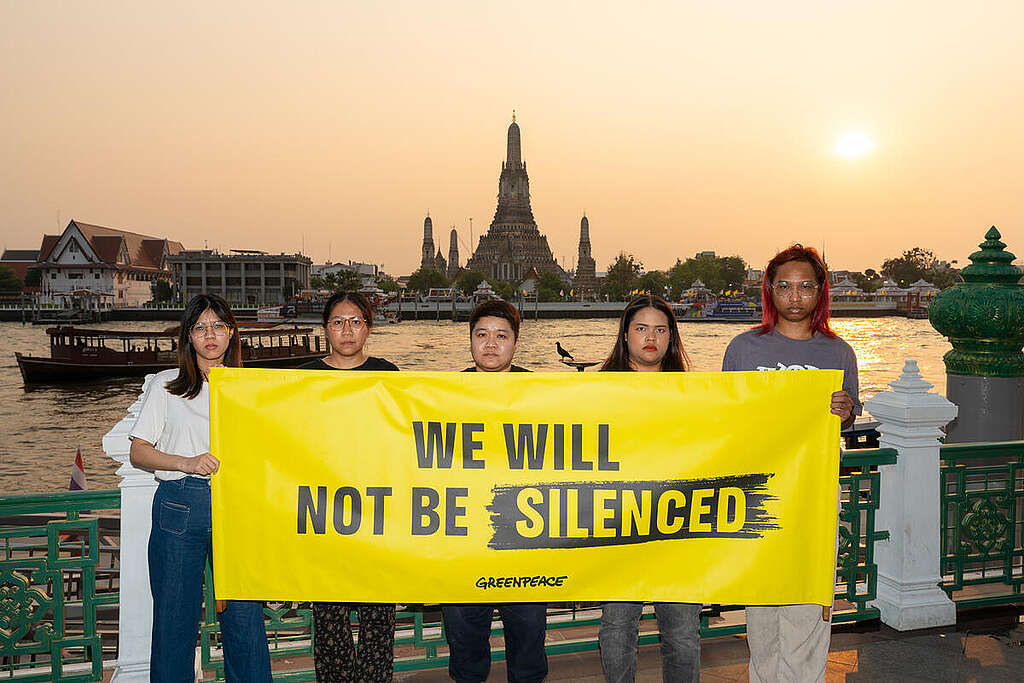
 Thailand: Activists from Greenpeace Thailand gathered at an iconic place in Bangkok, Thailand, to show solidarity with the global movement for climate justice. Holding banners reading “We will not be silenced” and “Stop Big Oil Bullies”, the group called for an end to the intimidation tactics used by fossil fuel companies like Energy Transfer, attempting to intimidate climate activists, journalists, and anyone who dares speak truth to power.
Thailand: Activists from Greenpeace Thailand gathered at an iconic place in Bangkok, Thailand, to show solidarity with the global movement for climate justice. Holding banners reading “We will not be silenced” and “Stop Big Oil Bullies”, the group called for an end to the intimidation tactics used by fossil fuel companies like Energy Transfer, attempting to intimidate climate activists, journalists, and anyone who dares speak truth to power.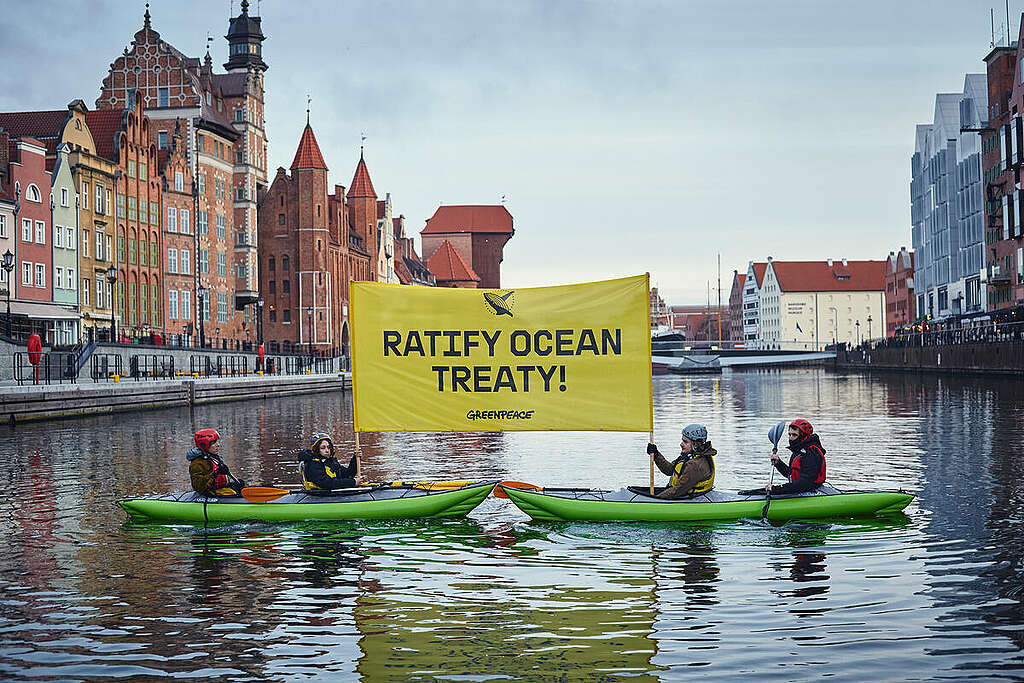
 Poland: Greenpeace Poland activists on kayaks in Gdansk demanded an urgent ratification of the Ocean Treaty. For more than two decades, Greenpeace and other civil society organizations have been seeking a Global Oceans Treaty to protect marine ecosystems from harmful industries, the Global Ocean Treaty. More than 60 countries have now ratified the agreement. This is a massive achievement for all the activists, supporters and allies who stood up and raised their voices for ocean protection in recent years.
Poland: Greenpeace Poland activists on kayaks in Gdansk demanded an urgent ratification of the Ocean Treaty. For more than two decades, Greenpeace and other civil society organizations have been seeking a Global Oceans Treaty to protect marine ecosystems from harmful industries, the Global Ocean Treaty. More than 60 countries have now ratified the agreement. This is a massive achievement for all the activists, supporters and allies who stood up and raised their voices for ocean protection in recent years. 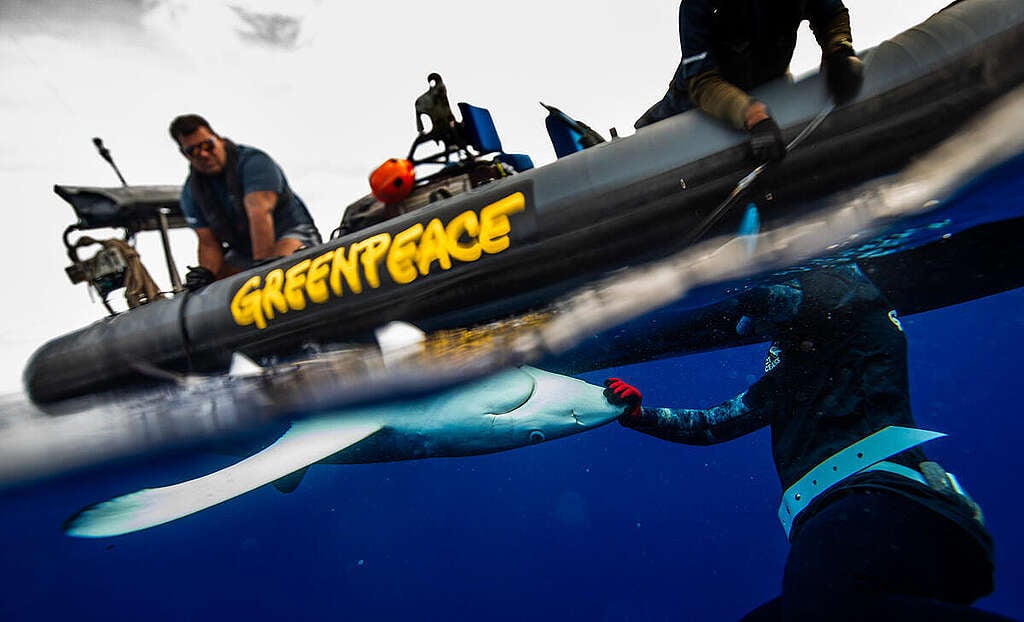
 Australia: A shark handler and Greenpeace RHIB team free a blue shark caught on a longline in the Pacific Ocean. The blue shark is currently listed as “Near Threatened” globally by the International Union for Conservation of Nature (IUCN). Greenpeace Australia Pacific took action to stop an industrial longlining fishing operation in the South Pacific Ocean, seizing more than 20 kilometres of fishing gear and freeing nine sharks, including an endangered mako, near Australia and New Zealand.
Australia: A shark handler and Greenpeace RHIB team free a blue shark caught on a longline in the Pacific Ocean. The blue shark is currently listed as “Near Threatened” globally by the International Union for Conservation of Nature (IUCN). Greenpeace Australia Pacific took action to stop an industrial longlining fishing operation in the South Pacific Ocean, seizing more than 20 kilometres of fishing gear and freeing nine sharks, including an endangered mako, near Australia and New Zealand.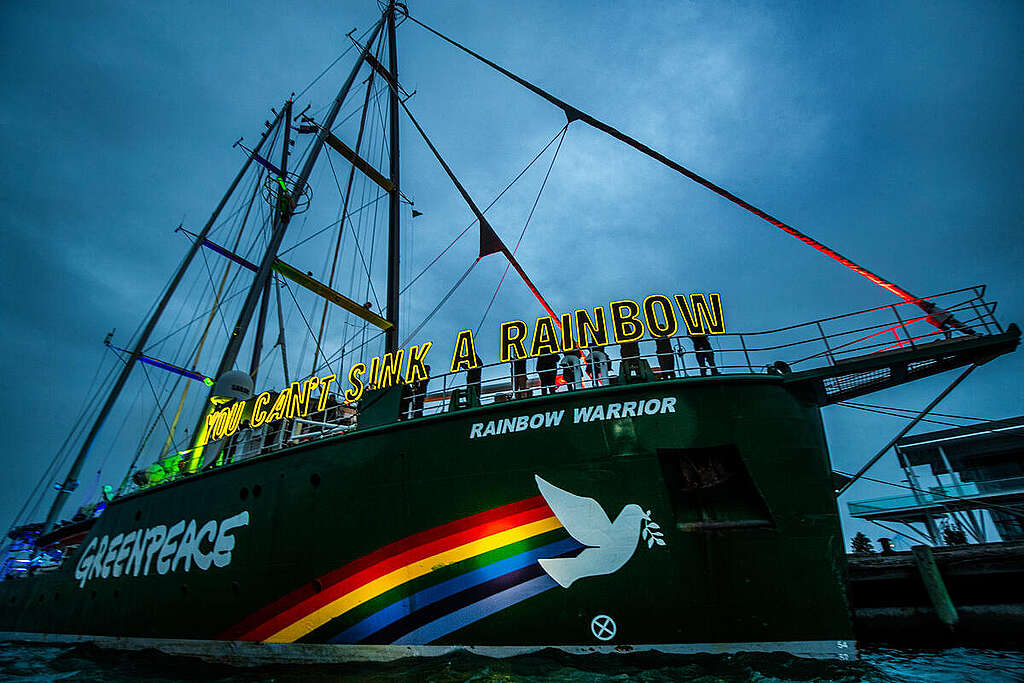
 New Zealand: The Rainbow Warrior is lit up as a “beacon of resistance” in Auckland today on the eve of the 40th anniversary of the bombing of the original Rainbow Warrior by French Government agents in 1985. Twenty crew and Greenpeace Aotearoa staff and volunteers hold letters of light spelling out the iconic phrase, You Can’t Sink A Rainbow.
New Zealand: The Rainbow Warrior is lit up as a “beacon of resistance” in Auckland today on the eve of the 40th anniversary of the bombing of the original Rainbow Warrior by French Government agents in 1985. Twenty crew and Greenpeace Aotearoa staff and volunteers hold letters of light spelling out the iconic phrase, You Can’t Sink A Rainbow.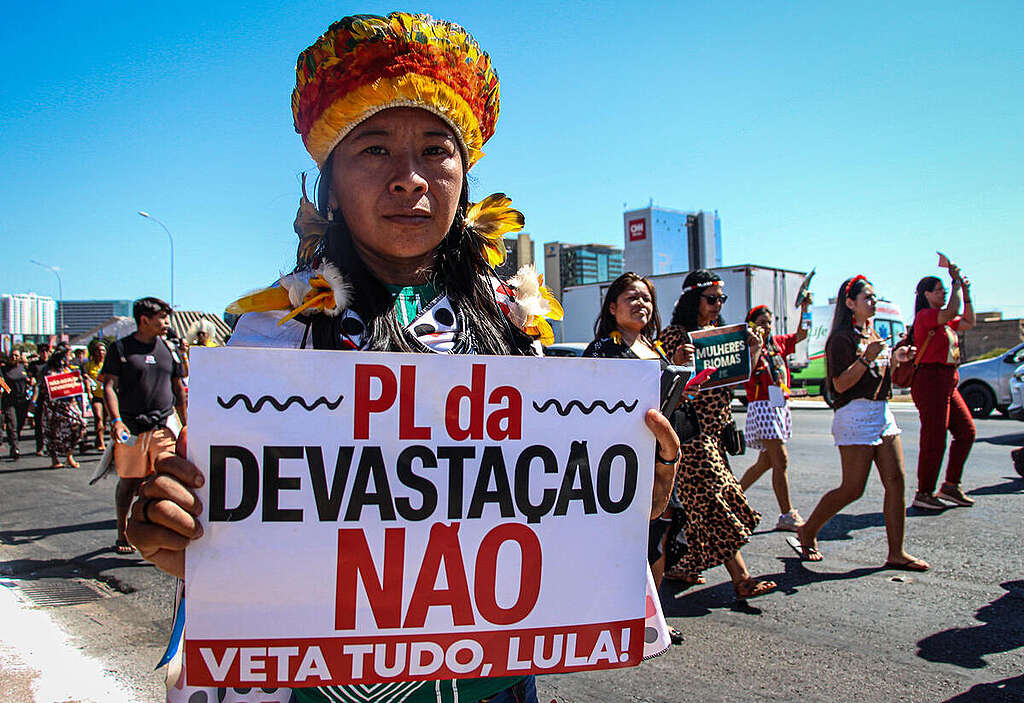
 Brazil: Between August 5 and 7, the Greenpeace Brazil Volunteer Team was in Brasília to participate in the 4th Indigenous Women’s March, which this year carried the theme: “Our Body, Our Territory: We Are Guardians of the Planet for the Healing of the Earth.” During the march, we joined forces with Indigenous women from across Brazil, carrying our banner reading “VET IT, LULA” in protest against the so-called “PL da Devastação”, which threatens to weaken environmental licensing and put forests, rivers, and traditional ways of life at risk. We also distributed themed hand fans, which featured information about the Indigenous Women’s House — a crucial initiative that provides shelter and specialized care. This meeting marked a significant step toward advancing public policies that ensure the protection and dignity of Indigenous women.
Brazil: Between August 5 and 7, the Greenpeace Brazil Volunteer Team was in Brasília to participate in the 4th Indigenous Women’s March, which this year carried the theme: “Our Body, Our Territory: We Are Guardians of the Planet for the Healing of the Earth.” During the march, we joined forces with Indigenous women from across Brazil, carrying our banner reading “VET IT, LULA” in protest against the so-called “PL da Devastação”, which threatens to weaken environmental licensing and put forests, rivers, and traditional ways of life at risk. We also distributed themed hand fans, which featured information about the Indigenous Women’s House — a crucial initiative that provides shelter and specialized care. This meeting marked a significant step toward advancing public policies that ensure the protection and dignity of Indigenous women.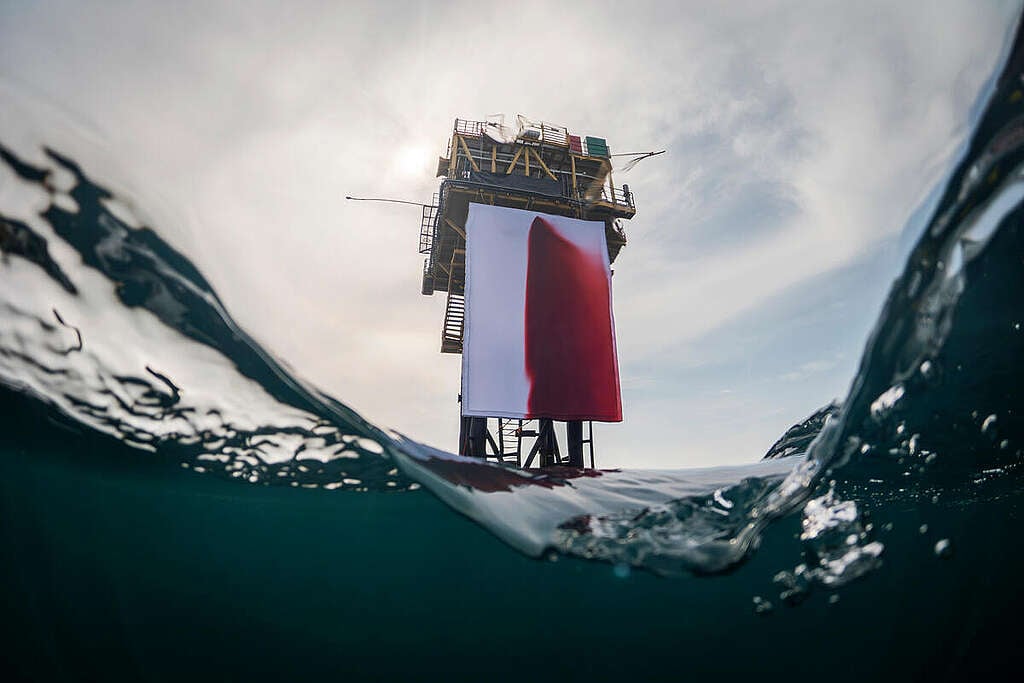
 United Kingdom: Greenpeace UK climbers install a major new work by renowned artist Anish Kapoor titled BUTCHERED onto a Shell platform in the North Sea – the world’s first artwork to be installed at an active offshore gas site. After securing a giant 12m x 8m canvas to one side of the structure, the activists hoisted a high-pressure hose onto the canvas at a height of 16 metres above the sea. They then pumped 1,000 litres of blood-red liquid that gushed into the fabric, creating a vast crimson stain. The work is a stark visualisation of the wound inflicted on both humanity and the Earth by the fossil fuel industry, evocative of our collective grief and pain at what has been lost, but also a cry for reparation.
United Kingdom: Greenpeace UK climbers install a major new work by renowned artist Anish Kapoor titled BUTCHERED onto a Shell platform in the North Sea – the world’s first artwork to be installed at an active offshore gas site. After securing a giant 12m x 8m canvas to one side of the structure, the activists hoisted a high-pressure hose onto the canvas at a height of 16 metres above the sea. They then pumped 1,000 litres of blood-red liquid that gushed into the fabric, creating a vast crimson stain. The work is a stark visualisation of the wound inflicted on both humanity and the Earth by the fossil fuel industry, evocative of our collective grief and pain at what has been lost, but also a cry for reparation.
 The Philippines: Impacts of the combined effects of Severe Tropical Storm “Crising” (International name: Wipha) and the southwest monsoon’s torrential rains are being felt across the Philippines—flooding communities like those in Calumpit, Bulacan, and disrupting lives, livelihoods, and even important moments like weddings. Southeast Asia’s extended monsoon season brought in relentless rains in Nepal, Thailand, Vietnam, and Indonesia, causing some of the worst flooding in recent history. Over a hundred people have died in the region, and thousands have been forced to leave their homes.
The Philippines: Impacts of the combined effects of Severe Tropical Storm “Crising” (International name: Wipha) and the southwest monsoon’s torrential rains are being felt across the Philippines—flooding communities like those in Calumpit, Bulacan, and disrupting lives, livelihoods, and even important moments like weddings. Southeast Asia’s extended monsoon season brought in relentless rains in Nepal, Thailand, Vietnam, and Indonesia, causing some of the worst flooding in recent history. Over a hundred people have died in the region, and thousands have been forced to leave their homes.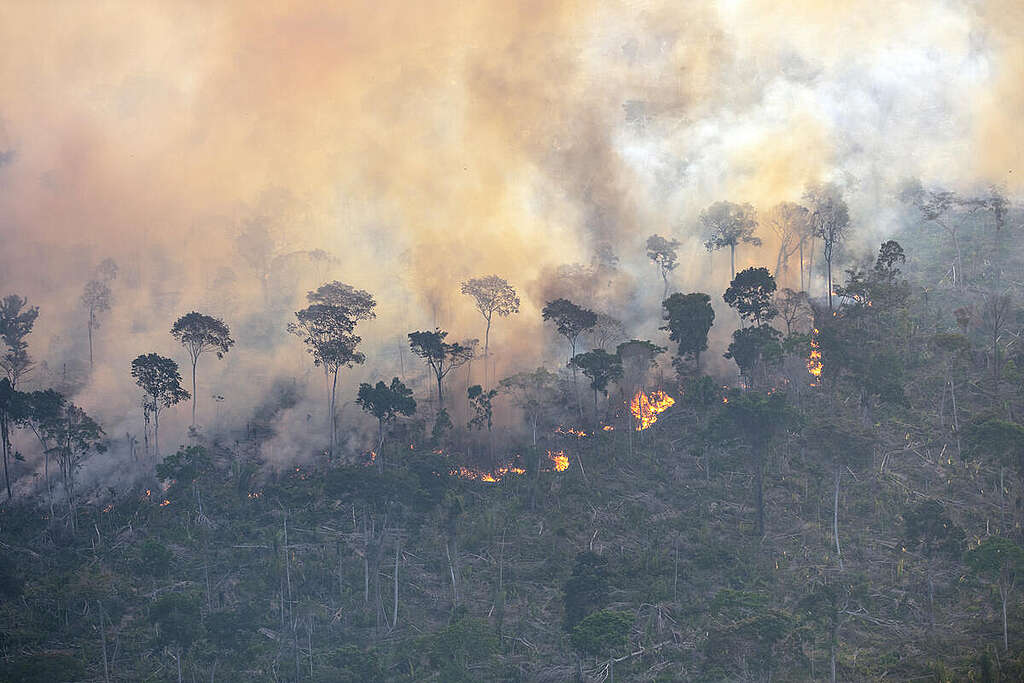
 Brazil: Greenpeace Brazil conducted an aerial survey in the Amazon region to monitor deforestation and forest fires. The flight documented cattle ranches, deforested areas, and environmental destruction. Influencers were invited to participate in the survey, helping to amplify the urgency of protecting the forest by sharing their experiences and reactions.
Brazil: Greenpeace Brazil conducted an aerial survey in the Amazon region to monitor deforestation and forest fires. The flight documented cattle ranches, deforested areas, and environmental destruction. Influencers were invited to participate in the survey, helping to amplify the urgency of protecting the forest by sharing their experiences and reactions.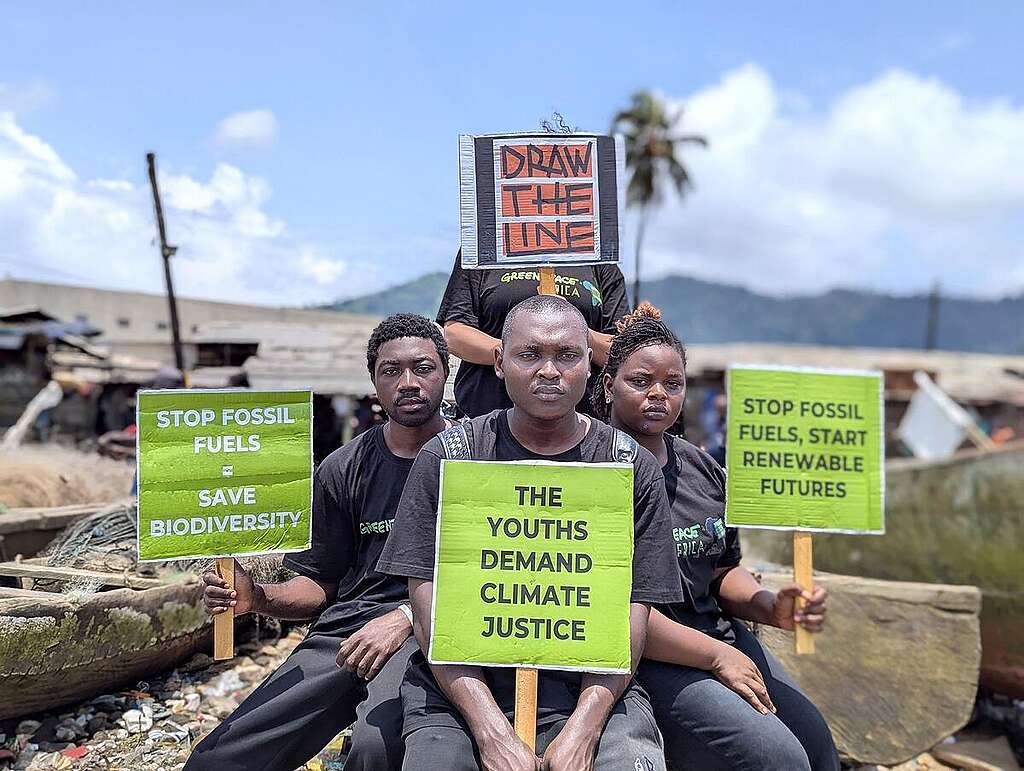
 Cameroon: In Cameroon, Greenpeace Africa volunteers Yaoundé and Buea will contribute through photo-ops, using visual storytelling to highlight environmental injustices and amplify the voices of youth demanding change.
Cameroon: In Cameroon, Greenpeace Africa volunteers Yaoundé and Buea will contribute through photo-ops, using visual storytelling to highlight environmental injustices and amplify the voices of youth demanding change.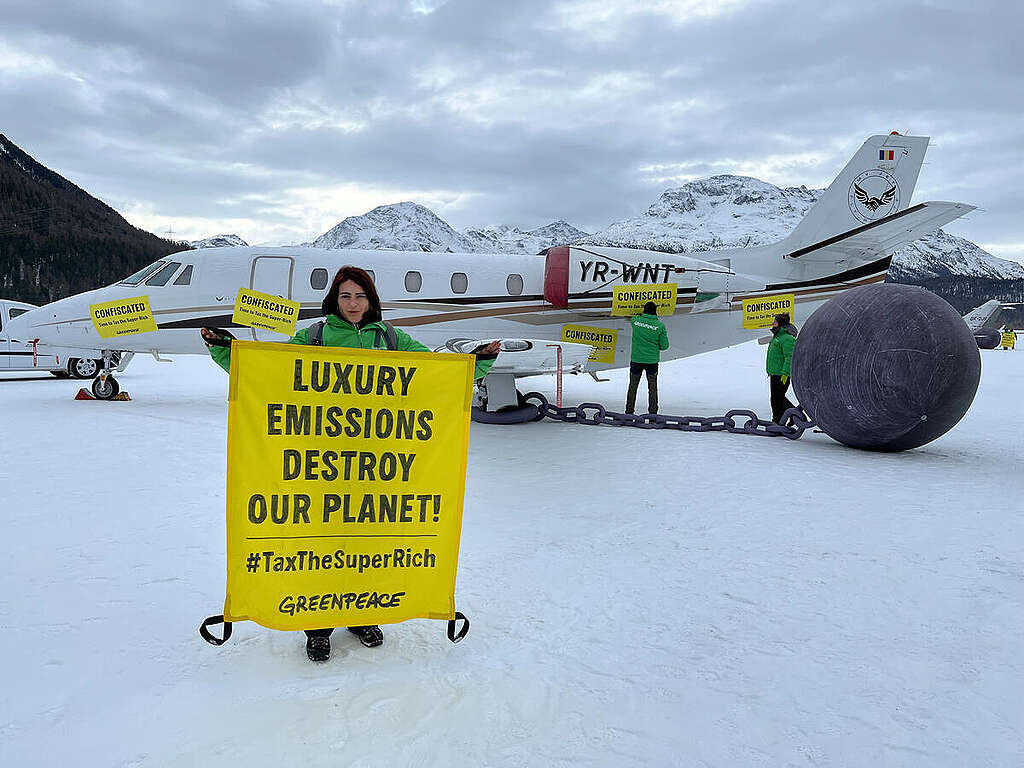
 Switzerland: The peaceful protest marks the last in a series of creative interventions calling on policymakers to tax the super-rich, who represent 1% of the world’s population, and redirect tax revenues towards affordable green housing, public transportation, and climate and environmental action, to support communities and protect the planet.
Switzerland: The peaceful protest marks the last in a series of creative interventions calling on policymakers to tax the super-rich, who represent 1% of the world’s population, and redirect tax revenues towards affordable green housing, public transportation, and climate and environmental action, to support communities and protect the planet.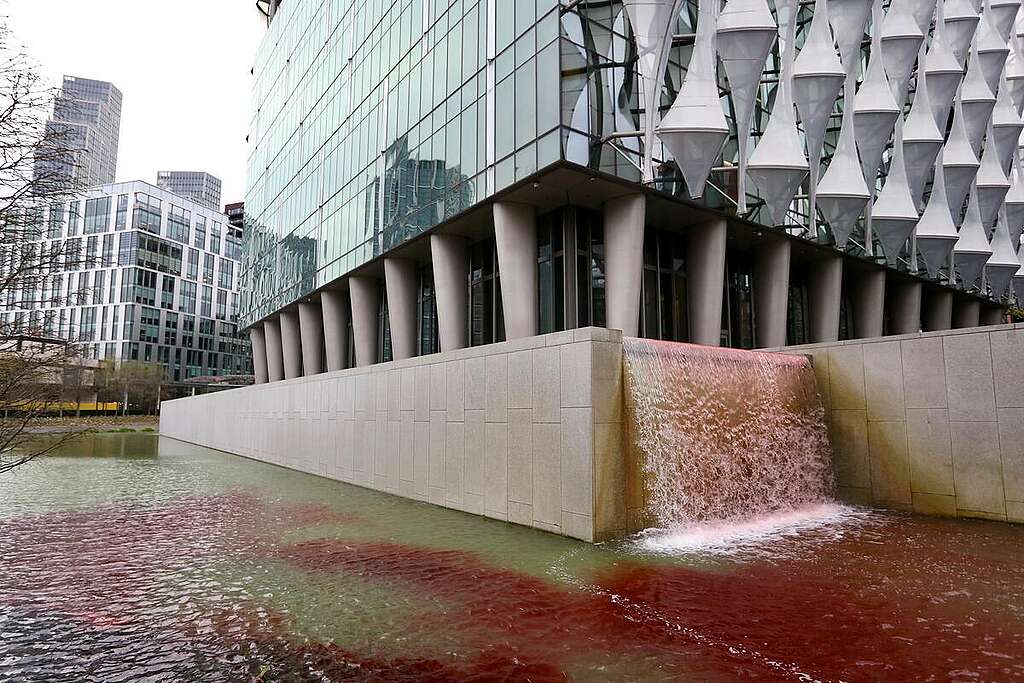
 United Kingdom: Greenpeace UK activists pour 300 litres of blood-red dye into the US Embassy pond in London, to highlight the death and devastation caused in Gaza as a direct result of the US’ continued sale of weapons, ammunition and military hardware to Israel. Twelve activists tipped the non-toxic, biodegradable dye from containers emblazoned with the words ‘Stop Arming Israel’ into the large pond located in front of the embassy building in Nine Elms, south-west London.
United Kingdom: Greenpeace UK activists pour 300 litres of blood-red dye into the US Embassy pond in London, to highlight the death and devastation caused in Gaza as a direct result of the US’ continued sale of weapons, ammunition and military hardware to Israel. Twelve activists tipped the non-toxic, biodegradable dye from containers emblazoned with the words ‘Stop Arming Israel’ into the large pond located in front of the embassy building in Nine Elms, south-west London.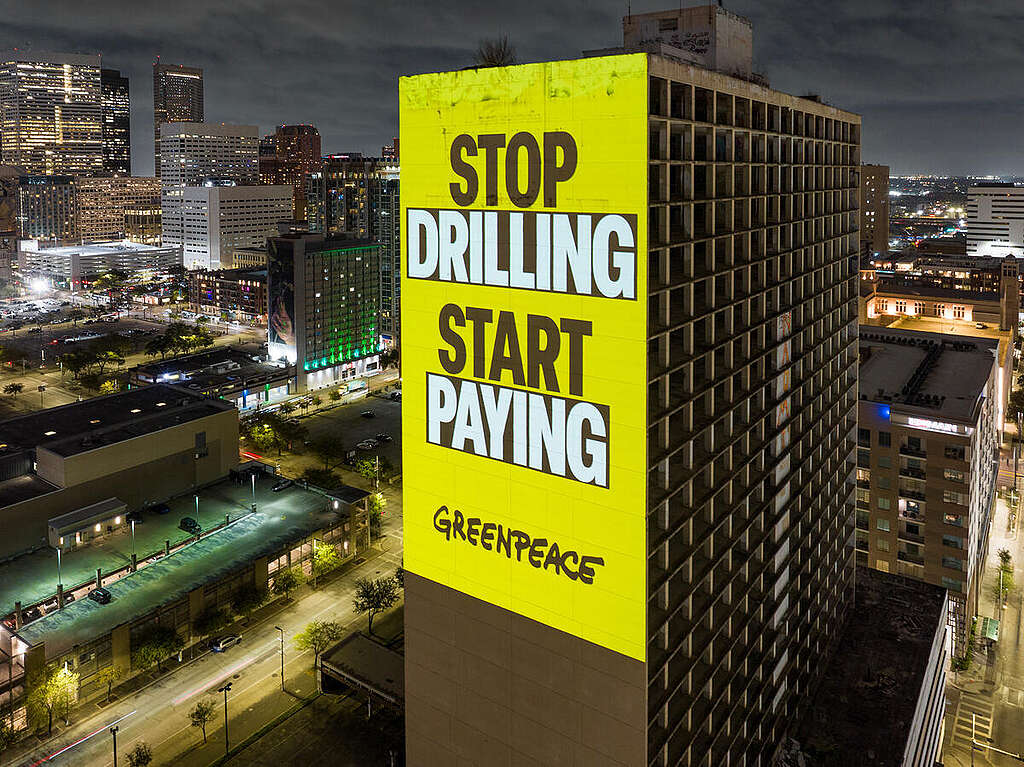
 United States of America (USA): A bold “Make Polluters Pay” projection lit up Houston during CERAWeek—the fossil fuel industry’s so-called “Super Bowl”—calling out Big Oil for its central role in driving the climate crisis. The campaign demands that the industry not only be held accountable for past damage, but also be forced to fund the costs of preparing our communities for the escalating impacts of climate change.
United States of America (USA): A bold “Make Polluters Pay” projection lit up Houston during CERAWeek—the fossil fuel industry’s so-called “Super Bowl”—calling out Big Oil for its central role in driving the climate crisis. The campaign demands that the industry not only be held accountable for past damage, but also be forced to fund the costs of preparing our communities for the escalating impacts of climate change.Honorable mentions
Best of Greenpeace action photos 2025
Sudhanshu Malhotra
Actions and protests make up the soul of Greenpeace. Every time an activist is climbing an oil rig or holding up a banner, I hope this inspires people across the globe to also take their own action. 2025 was a highly active year, with actions taking place in various cities and seas worldwide, representing the core of Greenpeace’s values. Check out some of the best images from our action teams across the world in 2025. Volunteers from Greenpeace Brazil unveiled a 12-meter banner with the message “Respect the Amazon” during Lady Gaga’s pre-show in Copacabana on May 3. On the third annual day of Russia starting the war against Ukraine, fifteen Greenpeace activists protest against environmentally damaging Russian oil exports using run-down tankers from the so-called shadow fleet on the Baltic Sea off Rostock. From inflatable boats, the Polish, Swedish, Danish, Ukrainian and German environmentalists painted ‘RISK!’ in large yellow letters on the tankers’ side as the ‘Prosperity’ passed by. A team from Greenpeace Italy and Greenpeace Germany projected the message “Hear my cry for help” onto the Presena glacier in the Italian Alps to denounce how climate change is contributing to its melting and the consequences of losing a vital water reserve. Greenpeace activists free a blue shark caught on a longline in the Pacific Ocean. The blue shark is currently listed as “Near Threatened” globally by the International Union for Conservation of Nature (IUCN). Greenpeace Australia Pacific took action to stop an industrial longlining fishing operation in the South Pacific Ocean, seizing more than 20 kilometres of fishing gear and freeing nine sharks, including an endangered mako, near Australia and New Zealand. Greenpeace climbers install a major new work by renowned artist Anish Kapoor titled BUTCHERED onto a Shell platform in the North Sea – the world’s first artwork to be installed at an active offshore gas site. After securing a giant 12m x 8m canvas to one side of the structure, the activists hoisted a high-pressure hose on top of the canvas at a height of 16 metres above the sea. They then pumped 1,000 litres of blood-red liquid that gushed into the fabric, creating a vast crimson stain. The work is a stark visualisation of the wound inflicted on both humanity and the Earth by the fossil fuel industry, evocative of our collective grief and pain at what has been lost, but also a cry for reparation. Greenpeace Indonesia holds a photo-op “Boots to boost justice” using fishers’ boots in Muara Baru fishery port, North Jakarta. As part of World Oceans Day, Greenpeace Mexico hosted a Festival of Monumental Kites featuring various figures of marine species at Holi Beach. A group of 17 giant kites with colourful shapes that evoke the life that inhabits this great aquatic territory were displayed in the sky with the message “Without oceans there is no future”. Activists from seven countries participate in an action with Greenpeace Italy against climate-wrecking fossil gas at the new liquefied gas import terminal in Ravenna. At sea, activists reached the infrastructure and attached large banners on it reading “Burn, baby, burn” referencing President Trump’s mantra “Drill, baby, drill” alongside an image of a burning Earth flanked by the faces of US President Donald Trump and Italian Prime Minister Giorgia Meloni. Greenpeace Africa joined local and Indigenous communities for the Forest Cultural Show (Indigenous People’s Day celebration) in Yaounde, Cameroon, to learn about their environmental protection efforts, share their cultures, and explore sustainable solutions for the future. Together, they marked Indigenous Peoples’ Day. Greenpeace Africa documented how the communities apply ancestral knowledge and traditional practices to protect the forest and peatlands they depend on. The Rainbow Warrior, Greenpeace’s flagship that for decades has carried a message of defending life to every corner of the planet, is in Cartagena, Colombia, reminding us that the Amazon is not negotiable: it is respected and defended. During its passage through Colombia, on the way to COP30 to be held in Belém, Brazil, it reminded us of the urgency of stopping deforestation, protecting biodiversity and guaranteeing fair financing for indigenous peoples and local communities, who have cared for the forests for generations. In Belém, Greenpeace will demand concrete commitments: zero deforestation by 2030, direct financing and environmental governance that puts life as a priority. A few hours before the start of the COP30 in Brazil today, a Greenpeace activist walked along a highline 30 meters above the center of Madrid with a 30-square-meter banner bearing the slogan “The planet on a tightrope.” With this unprecedented action, the environmental organization seeks to demand that the governments meeting at COP put an end to fossil fuels and deforestation by 2030, halfway through what the scientific community has called the decisive decade in the face of the climate emergency. Greenpeace activists and volunteers march in the annual ‘We have had enough!’ protest for a more sustainable agriculture in Berlin. Environmental activists take to the streets with Greenpeace’s pig and cow balloons, banners, and signs. Ahead of a federal election, Greenpeace Canada’s activists projected powerful messages on the world-famous Niagara Falls: “Don’t Trump Canada”, “Elbows up” and “RESIST”. Greenpeace Canada is calling out politicians like Trump and Poilievre for spreading fear and division, while polluting industries like oil & gas seek to take advantage of a crisis they helped create. Greenpeace Canada is asking Poilievre and all political parties to protect people and the environment, not polluters and billionaires. This projection was also a solidarity statement in support of Greenpeace US, who has been found liable for more than US$660 million in the Energy Transfer SLAPP trial. The Rainbow Warrior arrives in Auckland, New Zealand, for the 40th anniversary of the bombing of the original Rainbow Warrior in Auckland by French Government agents in 1985. The Greenpeace flagship has just returned from taking action on bottom trawling on the Chatham Rise off New Zealand’s East Coast. Malaysian actress Sharifah Sofia holds a banner reads “Stop Deep Sea Mining” in front of the deep-sea vessel “Hidden Gem” which is anchored at sea in Labuan, Malaysia. The Hidden Gem, owned by AllSeas and commissioned by The Metals Company, is the deep-sea mining industry’s flagship vessel. It is currently in Labuan, Malaysia, in long-term storage. The Metals Company confirmed in late April that they have submitted the first-ever commercial mining application to the US government, with the company stating they are “ready to go”. Hundreds of people rally outside the “Summit on the Future of Energy Security”, in London. The summit is co-hosted by the UK government and the International Energy Agency and attended by officials from the pro-fossil fuels Trump administration. The demonstrators want an end to new drilling in UK waters, including new projects such as the controversial Rosebank oilfield, as well as a proper plan for transitioning the oil and gas workforce. Texte intégral (5905 mots)
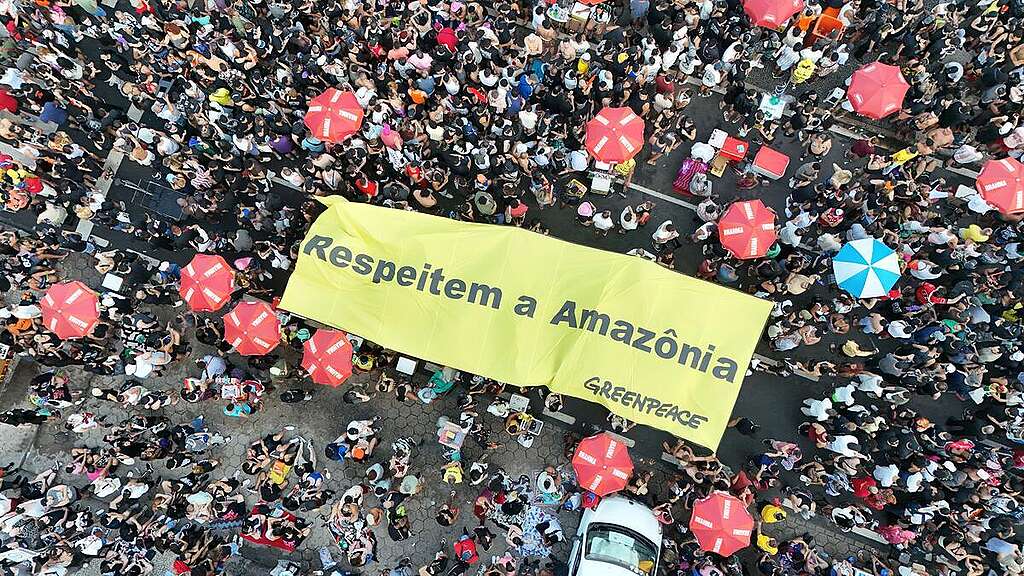
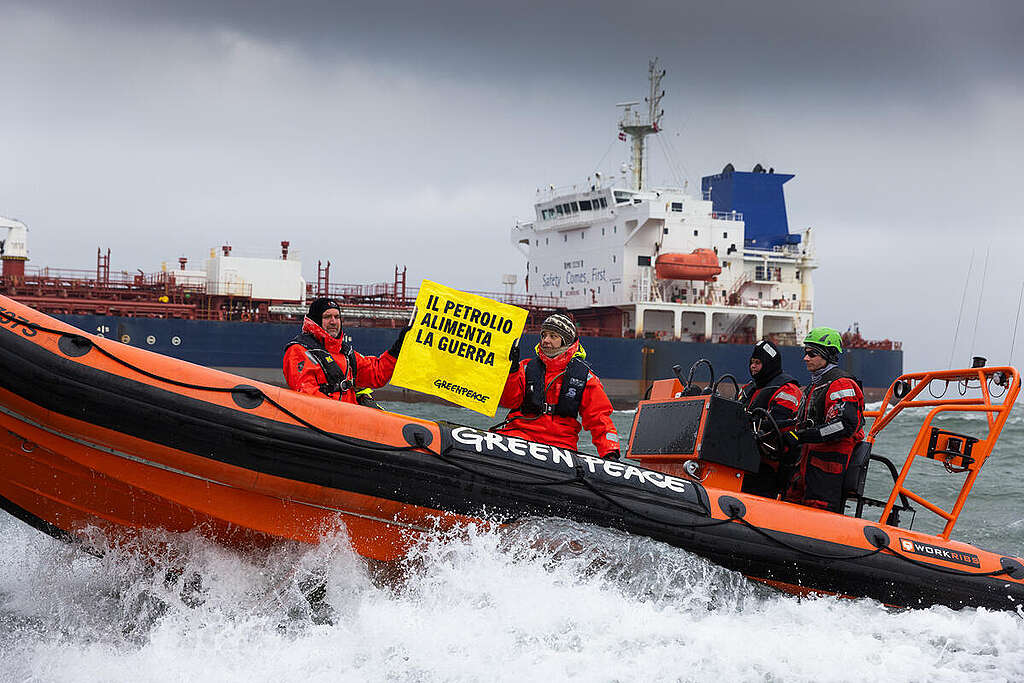
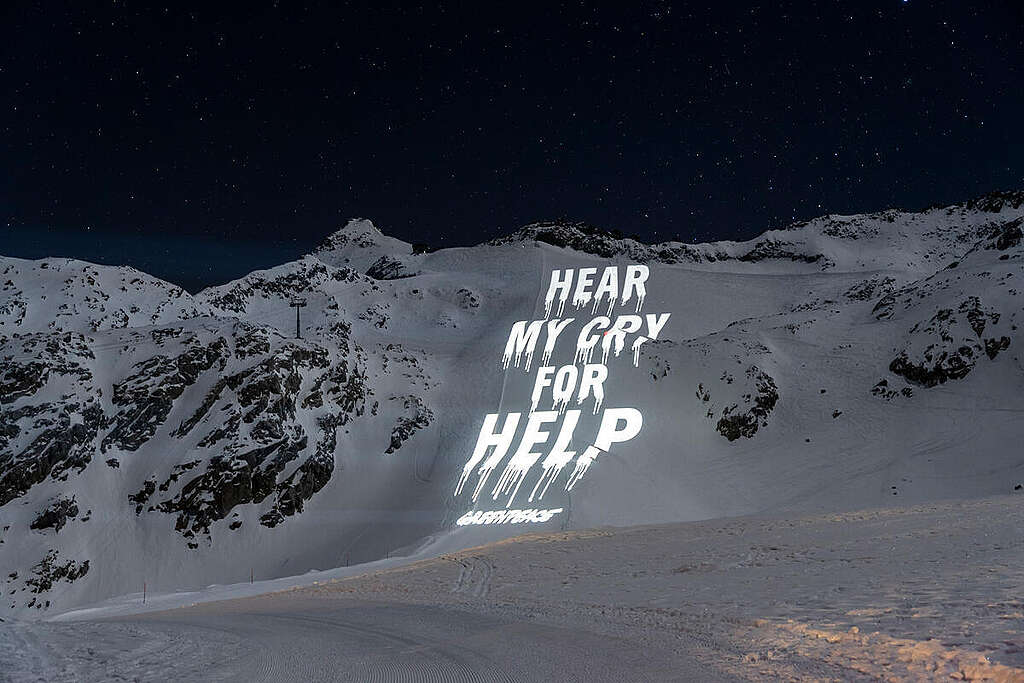
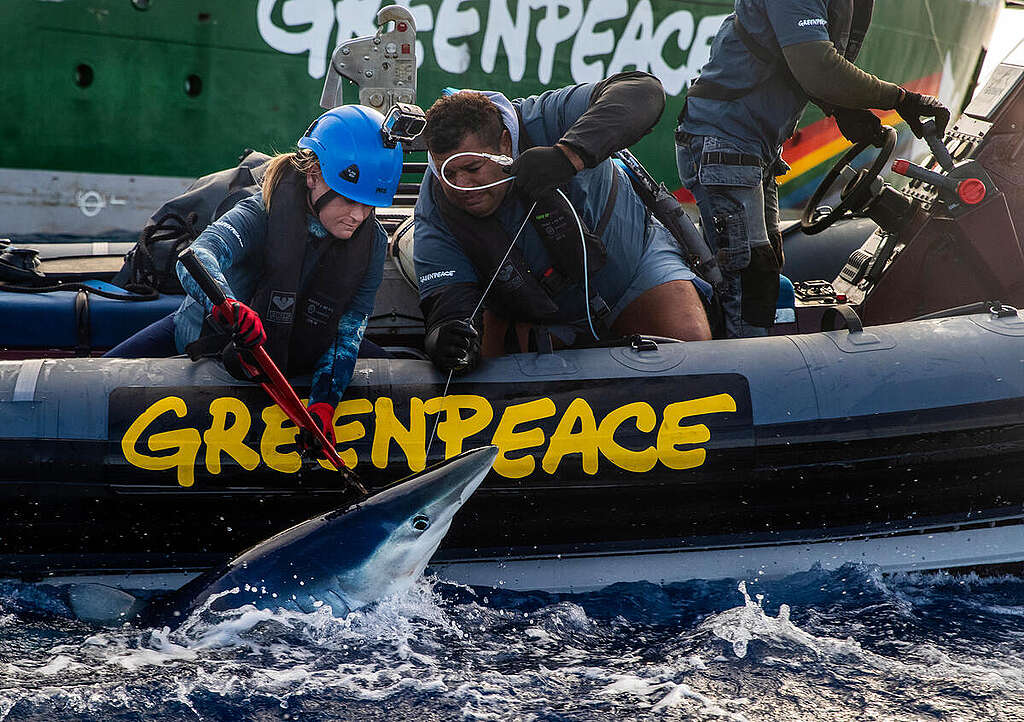
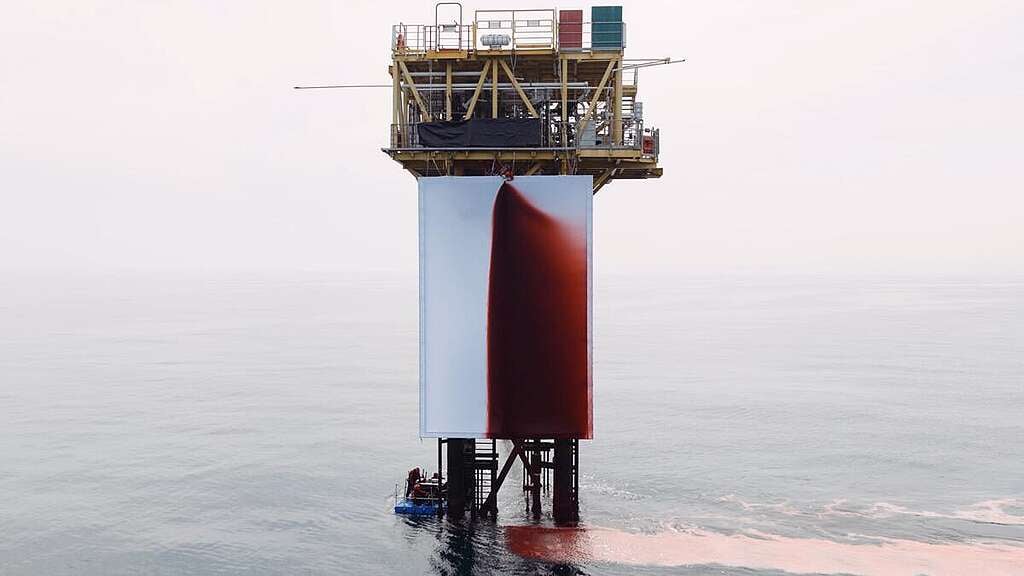
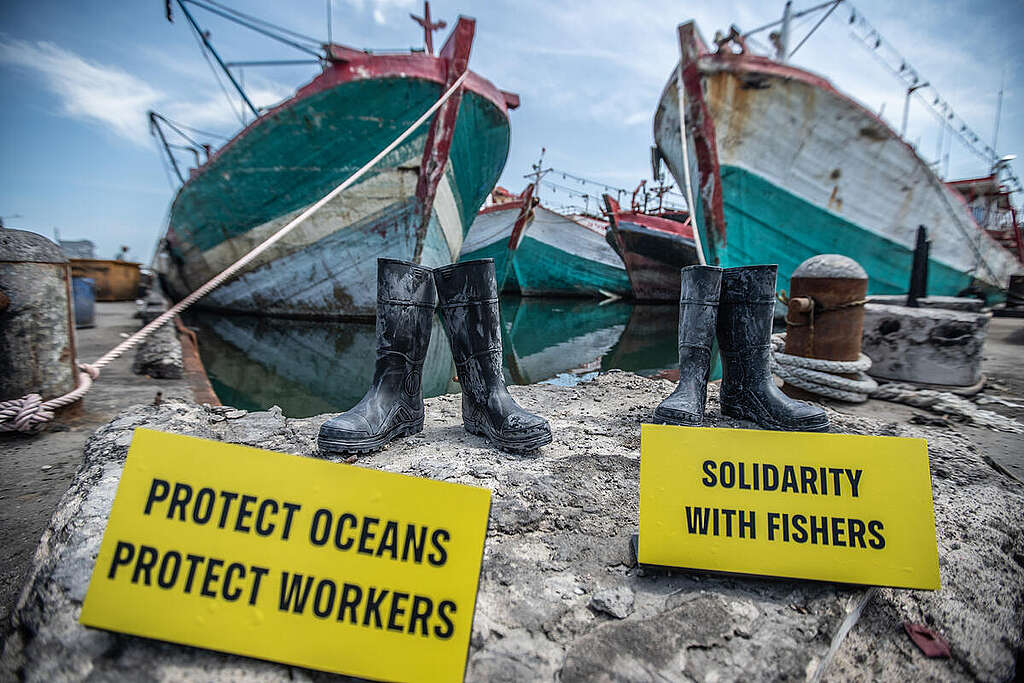
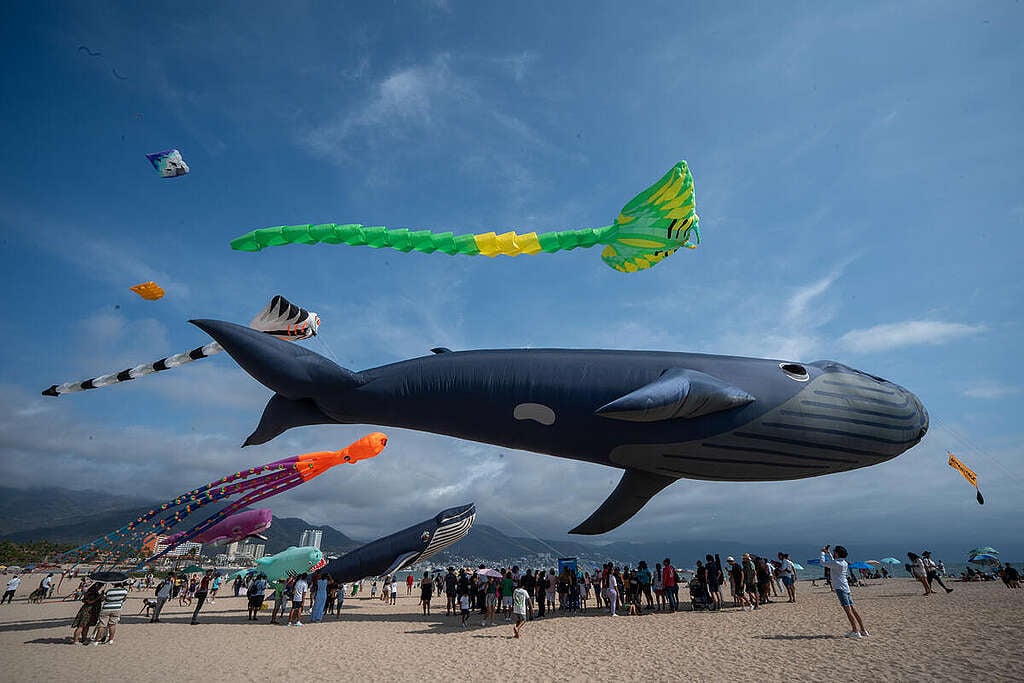
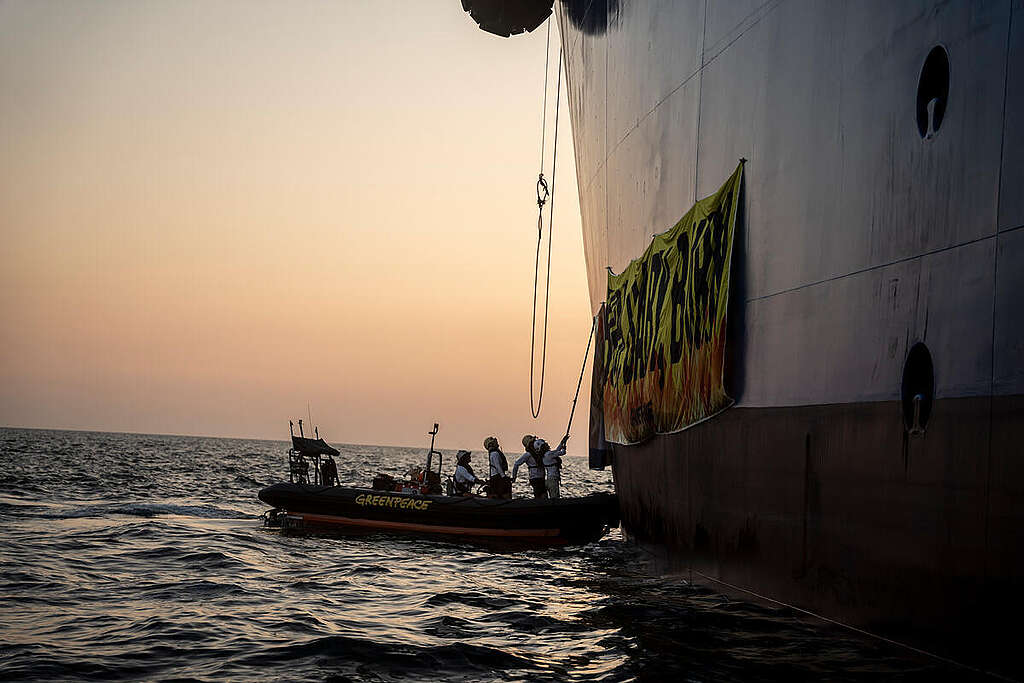
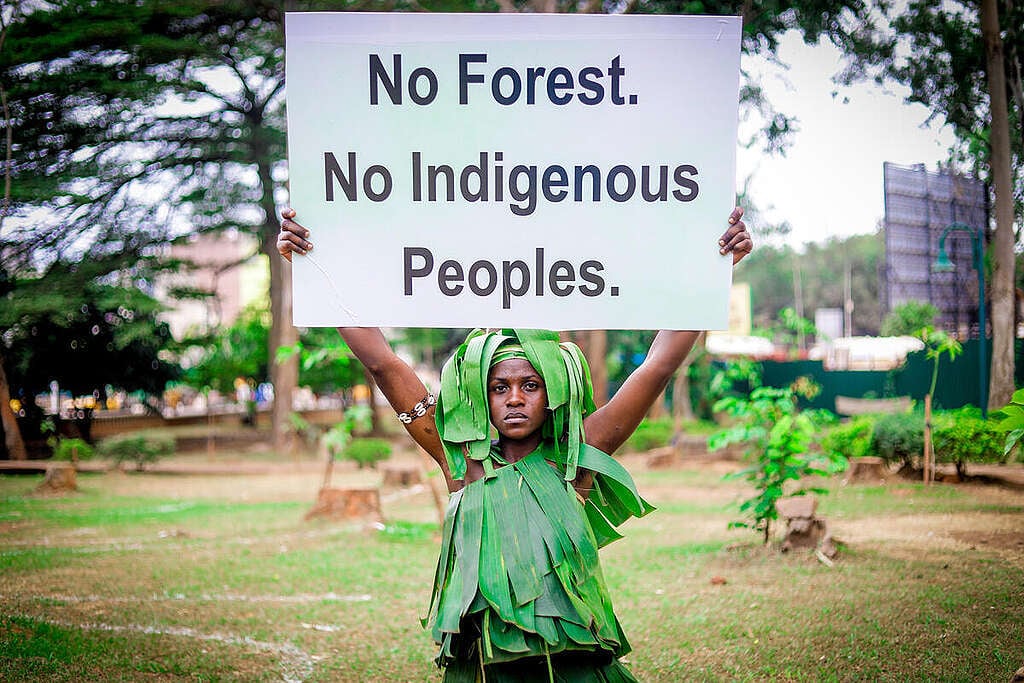
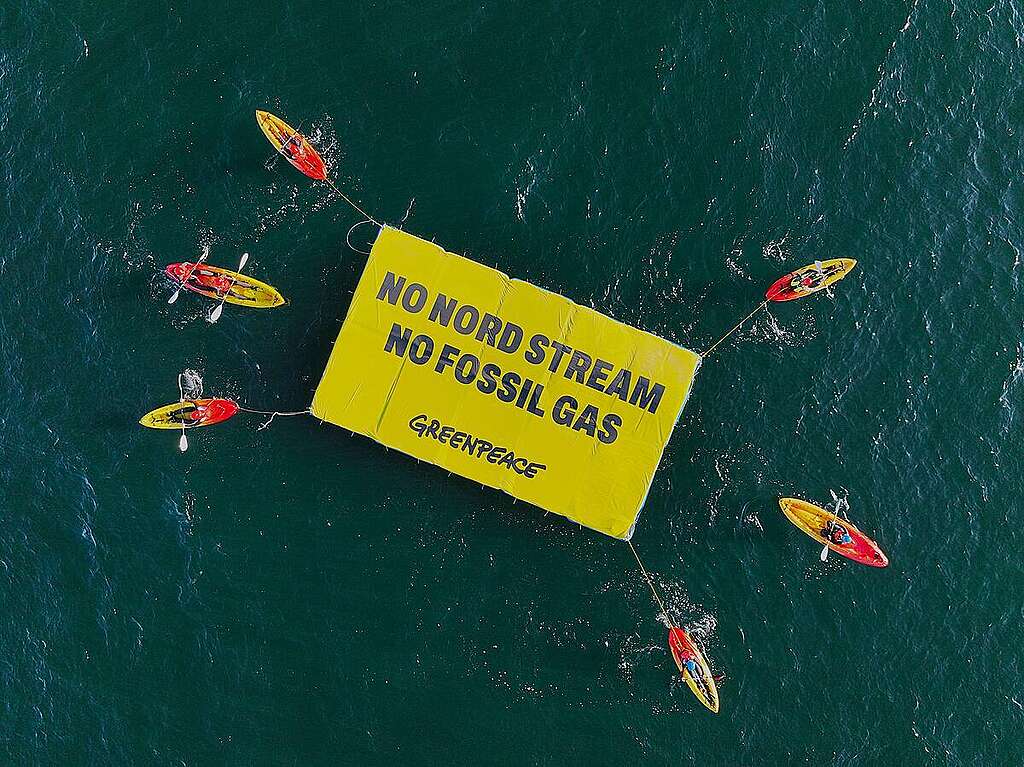
The Greenpeace ship Arctic Sunrise visited the Baltic Sea as part of the European campaign against fossil gas. There, Greenpeace activists from Poland, Ukraine, Germany, Belgium, the Netherlands and Italy paid a visit to the Nord Stream gas pipelines, which used to carry fossil gas from Russia to Europe. Greenpeace Poland demands a definitive shutdown of the Nord Stream pipelines, a phase-out of Russian fossil fuels by 2027, and a full phase-out of gas across the EU by 2035 at the latest.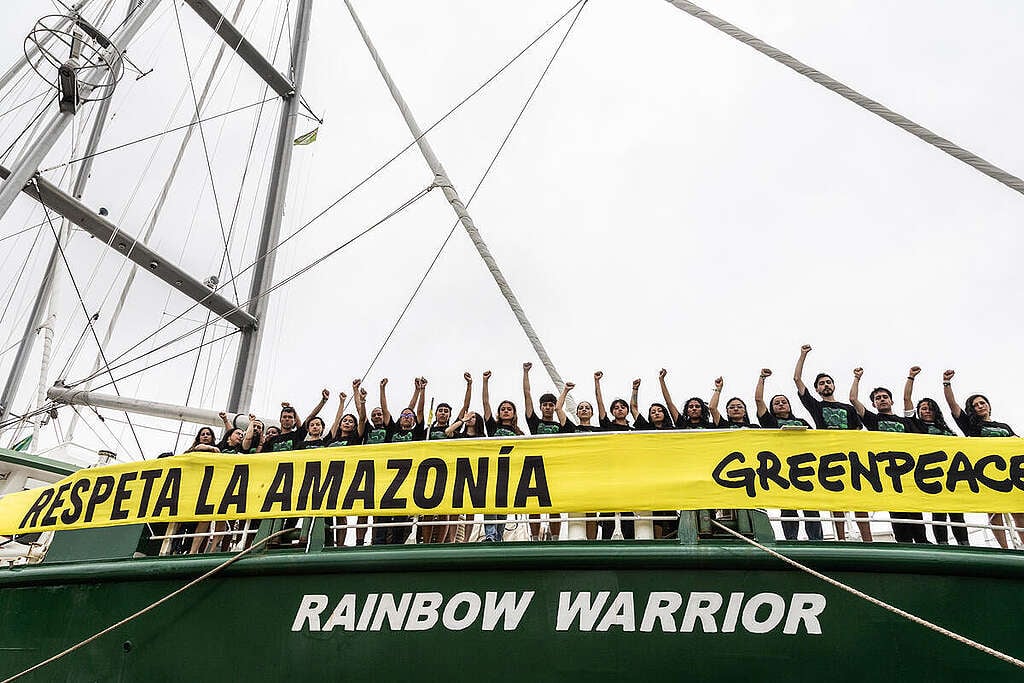
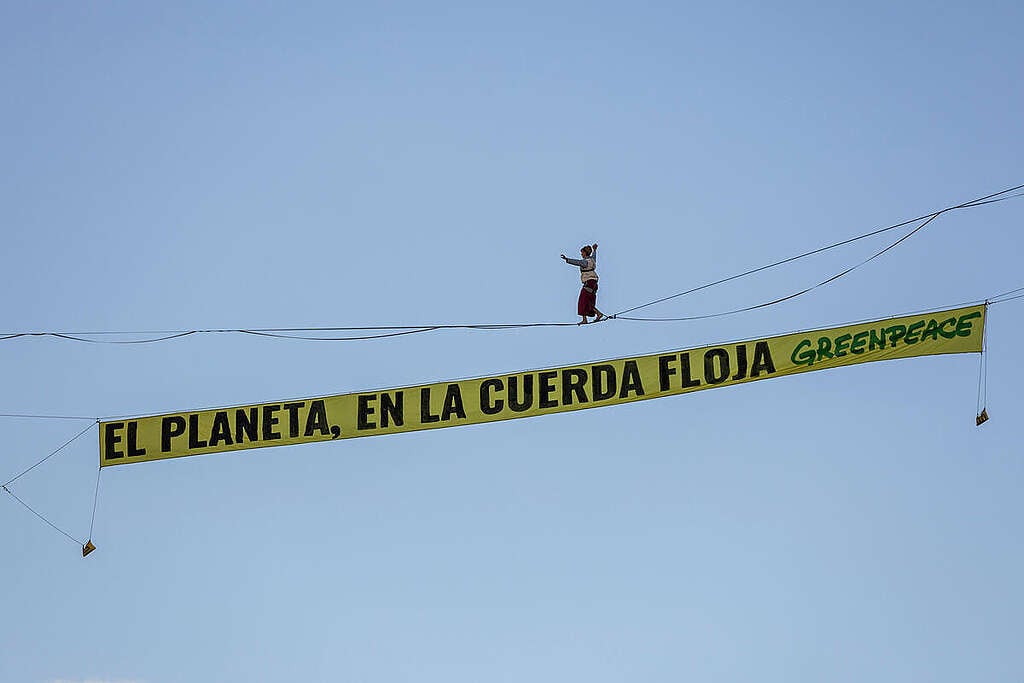
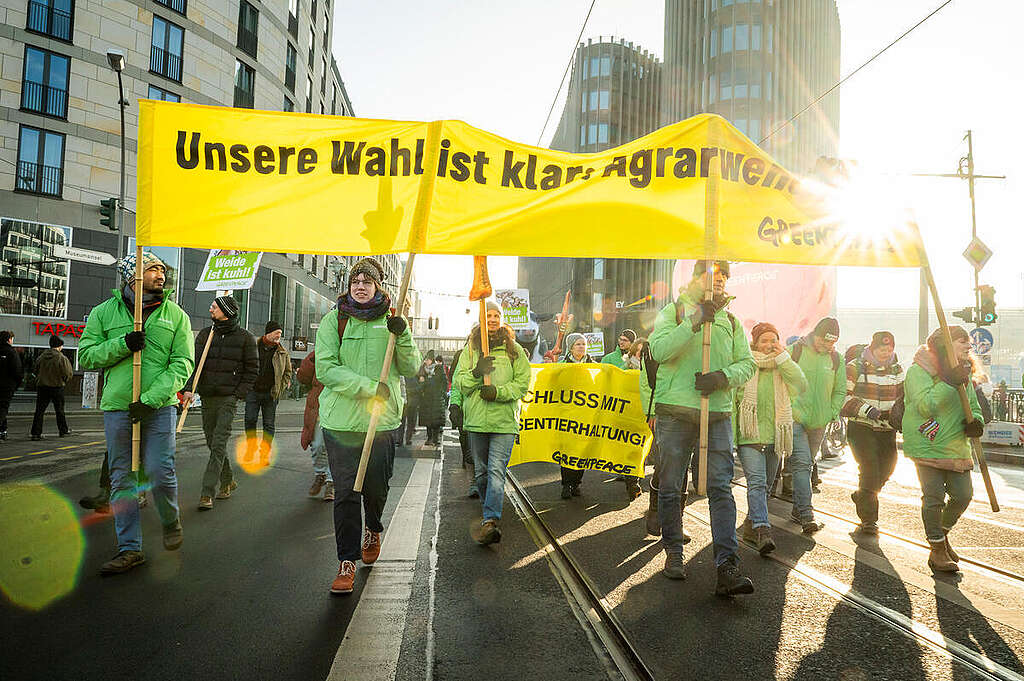
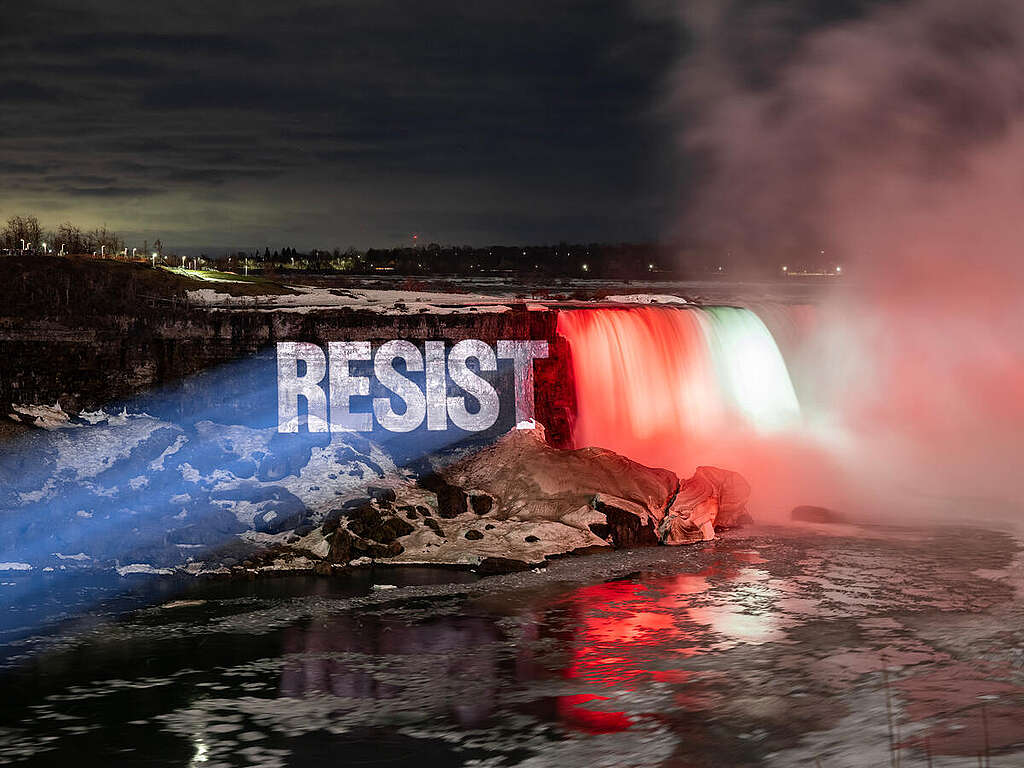
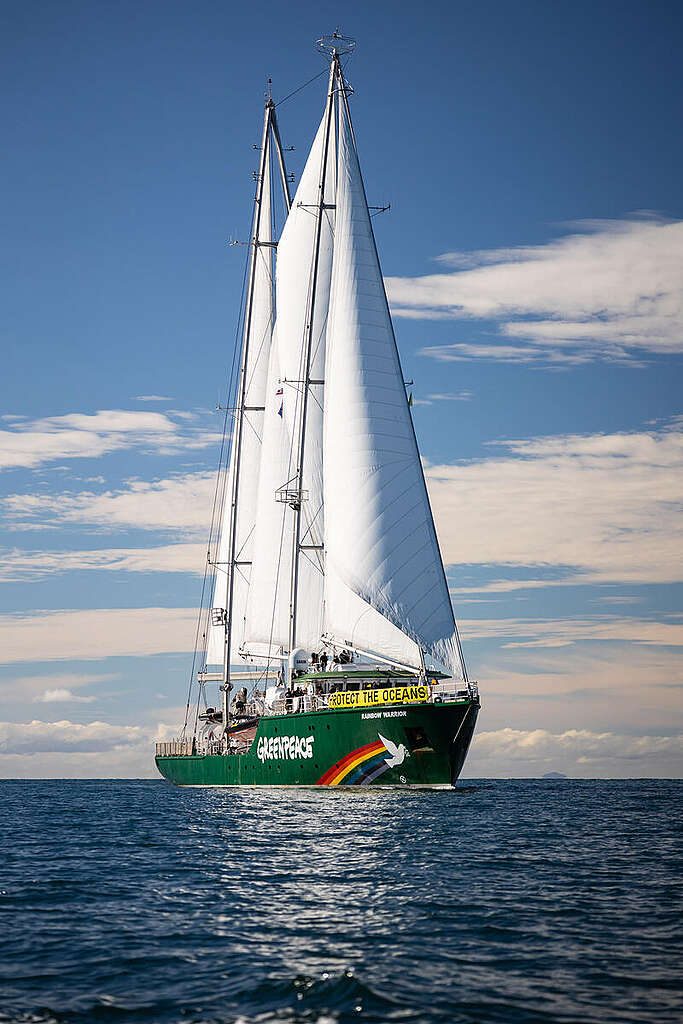
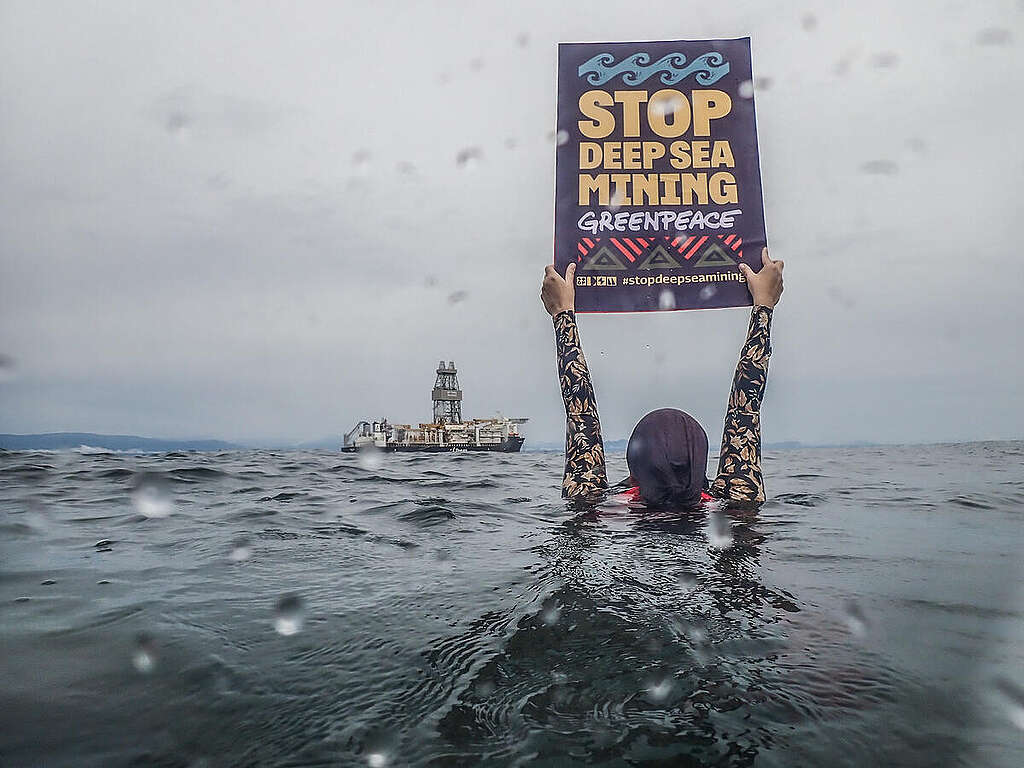
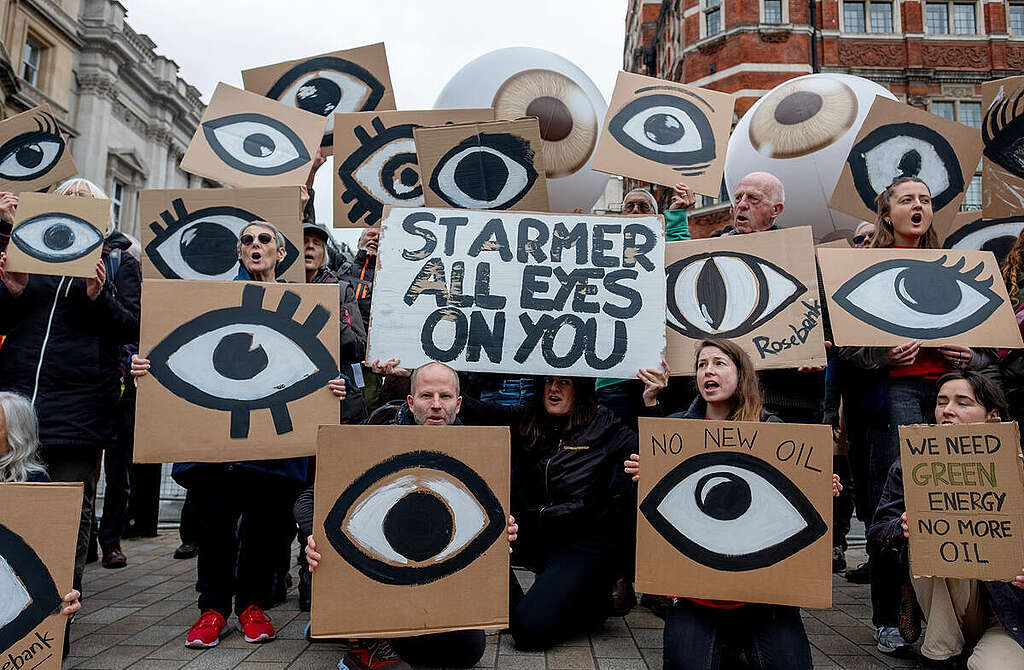
5 ways to disinvite plastic from your holidays
Sarah King
The holidays are here again. ‘Tis the season to hang out with (or just tolerate) family and friends, share (and maybe overindulge in) tasty meals, and enjoy festivities (or stay cozy and binge your comfort show). But no matter how you celebrate, the pressure to consume can be extreme. Capitalism’s overconsumption machine can make us think that we need to buy everything during the holidays, but as corporations pump out 430 million tonnes of plastic globally, plastic doesn’t need to get the invite to the big holiday party this year. Dodging certain holiday offerings and embracing some new anti-consumption traditions can be small but mighty acts of resistance against capitalism. Plastic is everywhere, and at this time of year it’s hiding in plain sight at your holiday gatherings. Plastic packaging is the most obvious major source of waste; however, a closer look at what many decorations and gifts are made of reveals all the other ways plastic creeps into our homes. It is in clothing, bags, bedding, childrens’ toys, holiday figurines, electronics, sports equipment, stuffed animals, cosmetics, kitchenware, furniture, the stir stick in your cocktail or mocktail — the list goes on. Why does this matter? Because plastic pollutes air, water, nature and our bodies, across its entire lifecycle. And it’s causing widespread and devastating harm. Plastic isn’t only a waste and pollution issue, it has morphed into a grave public health concern. The more plastic the industry produces, the more we’re pressured to consume, and the more pollution people and the planet are exposed to. The season of giving doesn’t have to be giving plastic disaster. We’re here to share 5 ways to beat those consumption blues. It’s never been easier to find pre-loved items in our communities. From thrift shops to antique stores, clothing swaps to flea markets, and numerous online platforms, most gift ideas you have can be found used with a bit of time and resourcefulness. Dodging big corps whenever possible isn’t only satisfying, it’s a win for your wallet and the planet. According to Earth Overshoot Day and its partners, by July 24th, 2025 humanity was using nature about 1.8 times faster than the Earth’s ecosystems are able to regenerate, so reducing demand for new materials is part of our collective consumption reduction equation. If you look at the plastic all around you today, it is set to have more than doubled in the next 25 years. Any signal we can send to big plastic producers and consumer goods companies that plastic isn’t fantastic, can help incentivize them to choose alternatives, and show governments that we support real solutions to the plastic problem. It’s a lovely time of year for meals out and coffee dates but because non-toxic, reusable containers are not yet ubiquitous, bringing your own plastic-free containers whenever possible will reduce your plastic exposure and footprint. Plastic-lined coffee cups, “bioplastic” packaging and cutlery, and even take-out containers labeled as reusable, present an opportunity for contaminating our food and our bodies with microplastics and chemicals. Various kitchenware items in our homes also contain plastic. Large plastic spatulas and spoons, sieves and strainers, cutting boards, storage containers, sippy cups, electric kettles, blenders and Teflon or coated pans all can contain or are made from plastic. Scientists have begun to uncover how using these types of items contributes to our ingestion of microplastics and exposure to potentially toxic chemicals. There’s nothing festive about a charcuterie board seasoned with microplastics. It’s not easy or affordable to do a full kitchen overhaul, but you can start by doing small changes like ditching plastic cutting boards, never heating plastic, and using stainless steel or cast iron instead of coated pots and pans. When hosting, remember reusable is best — ditch the single-use plates, cups, and cutlery and just use what you have on hand. Crowd source dishware when needed, that’s what friends are for. Who doesn’t want a little glitz at this time of year? So much of what is extra sparkly and shiny is a combination of plastic and metal, and it’s nothing but a beautiful nightmare. Glitter shows up in craft supplies, gift wrap, decorations, clothing, cosmetics, kids’ toys, costumes, party hats, and snow globes. Plastic glitter and sequins can easily shed into its surroundings, when clothing is being washed or crafts are being cleaned-up, it can shed down the drain, and when combined with paper or other materials, these products ruin recycling potential, sending them to landfill or incineration. And while some may claim to be biodegradable, it’s really not worth the potential pollution risk. Out with the old and in with the new can be a useful mantra when letting go of negative vibes or questionable habits, but when it comes to “stuff”, we all need to resist the temptation to get the newer, trendier, or upgraded item. We live in an era where we’re being given mixed messages about simplifying our lives and our relationship with material things. We’re told to buy more, but also buy better. Wide leg jeans today, skinny jeans tomorrow. But purging in the name of decluttering isn’t an act for the planet. It can also overburden donation organizations. Unless the purge is paired with a commitment to minimalist living, chances are a lot of that stuff will eventually be replaced, increasing the resource burden. Buying a bunch of new stuff can result in a bunch more plastic produced, so try to ponder before you purge and consider what might be reused, refurbished, re-manufactured, revived, refurnished, repurposed, remade, re-gifted, rotated out, rotated in, rearranged, reimagined, and/or relocated. Trying to dodge plastic can be exhausting. If you’re feeling overwhelmed, you’re not alone. We can only do so much in this broken plastic-obsessed system. Plastic producers and polluters need to be held accountable, and governments need to act faster to protect the health of people and the planet. The plastic crisis is a global problem demanding a global solution. We urgently need global governments to secure a strong UN Global Plastics Treaty that reduces global production and consumption, ends our reliance on problem plastics and chemicals, and accelerates a justice-centred transition to a reuse-based, zero waste future. Ensure your government doesn’t waste this once-in-a-generation opportunity to end the age of plastic. Ask world leaders to support a strong Global Plastic Treaty that addresses the whole life cycle of plastic. Sarah King is a Senior Campaign Strategist for the Plastic Free Future campaign at Greenpeace Canada. Texte intégral (2352 mots)
Global plastic reduction is the best gift

Normalize ‘new-to-you’ over brand new gifts.

Choose your containers and cookware with care

Glitter isn’t glam, your inner sparkle is enough!
Resist the urge to purge

Cozy up with a petition to change the world.
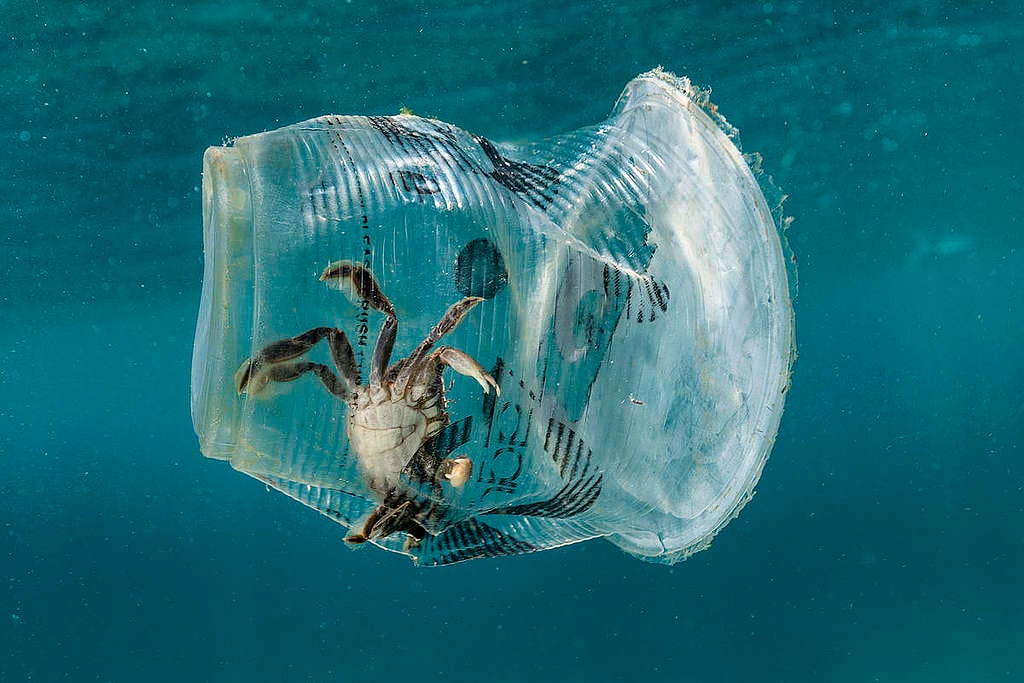
Greenpeace Pictures of the Week
Greenpeace International
Ten years since the Paris Agreement, a sunken cake, and clean air for kids. Here are a few highlights of Greenpeace work around the world in the past seven days. Greenpeace has been a pioneer of photo activism for more than 50 years, and remains committed to bearing witness and exposing environmental injustice through the images we capture. To see more Greenpeace photos and videos, visit our Media Library. Texte intégral (1653 mots)
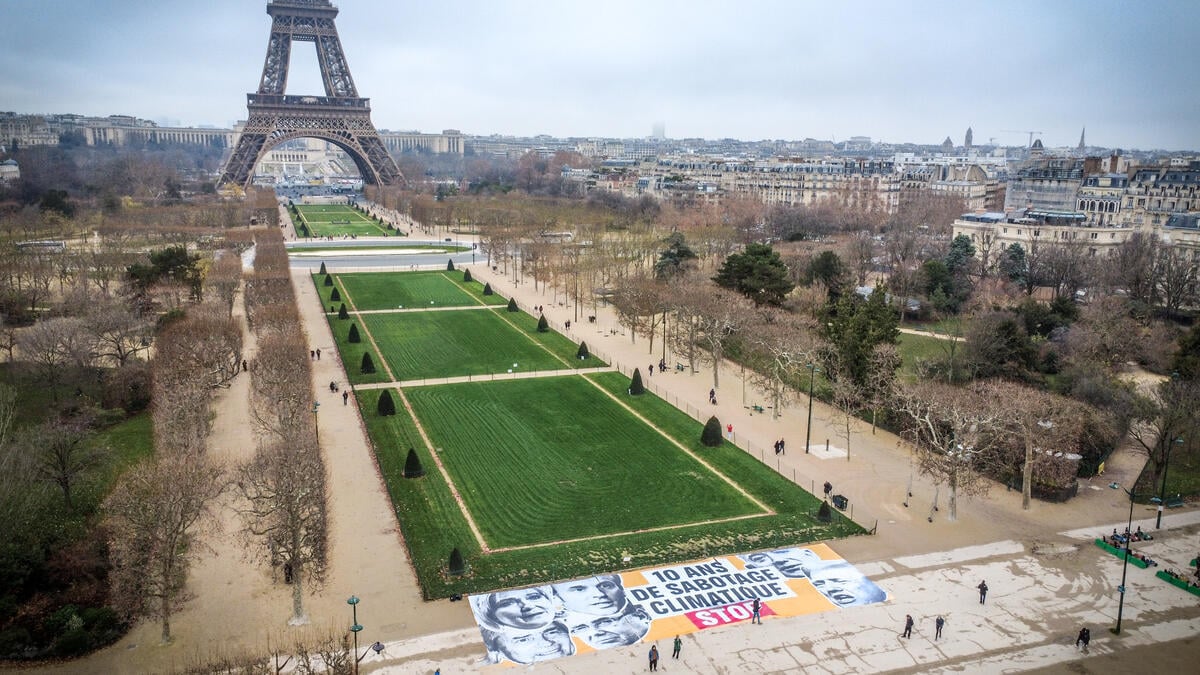
 France – On the occasion of the 10th anniversary of the Paris Agreement, Climate Justice Action, ANV-COP21 and Greenpeace France unfurled a 300-square-meter banner on the Champ-de-Mars in front of the Eiffel Tower in Paris, denouncing 10 years of climate sabotage and depicting the faces of Emmanuel Macron, Marine Le Pen, Vincent Bolloré, Patrick Pouyanné, Jeff Bezos and Donald Trump.
France – On the occasion of the 10th anniversary of the Paris Agreement, Climate Justice Action, ANV-COP21 and Greenpeace France unfurled a 300-square-meter banner on the Champ-de-Mars in front of the Eiffel Tower in Paris, denouncing 10 years of climate sabotage and depicting the faces of Emmanuel Macron, Marine Le Pen, Vincent Bolloré, Patrick Pouyanné, Jeff Bezos and Donald Trump.
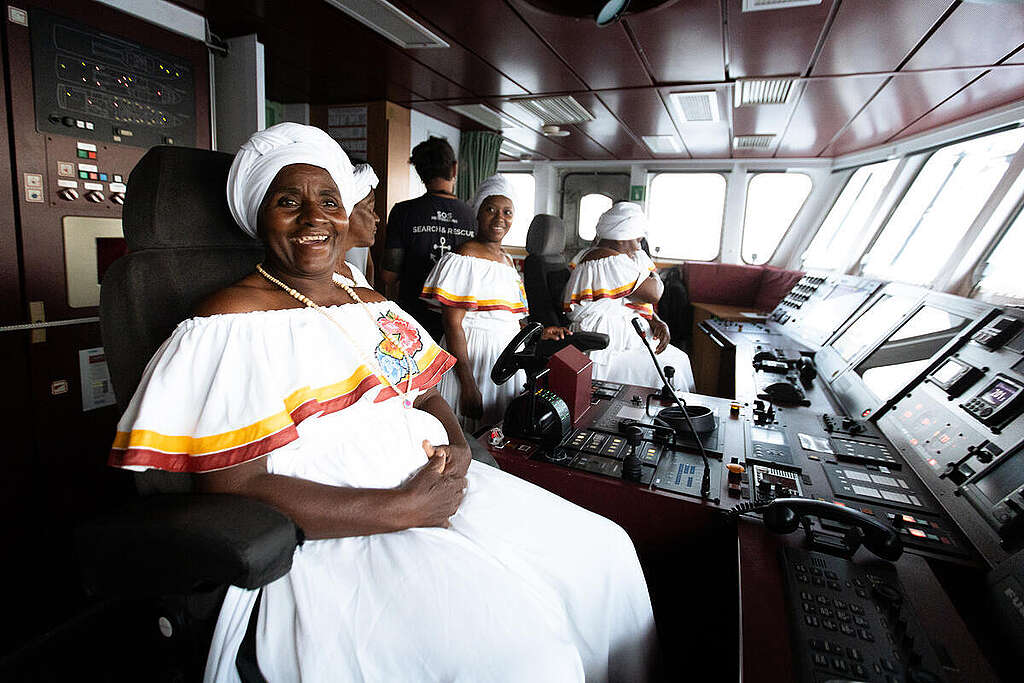
 Brazil – Leaders from Quilombo Mundo Novo Visit the Rainbow Warrior in Recife, northeastern Brazil. Quilombo Mundo Novo is located in the Serra da Torrada region—named after the traditional roasting of Brazil nuts in large pans. Today, the community is known for its samba de coco, an Afro-Brazilian cultural expression that blends music, poetry, and circle dance.
Brazil – Leaders from Quilombo Mundo Novo Visit the Rainbow Warrior in Recife, northeastern Brazil. Quilombo Mundo Novo is located in the Serra da Torrada region—named after the traditional roasting of Brazil nuts in large pans. Today, the community is known for its samba de coco, an Afro-Brazilian cultural expression that blends music, poetry, and circle dance.
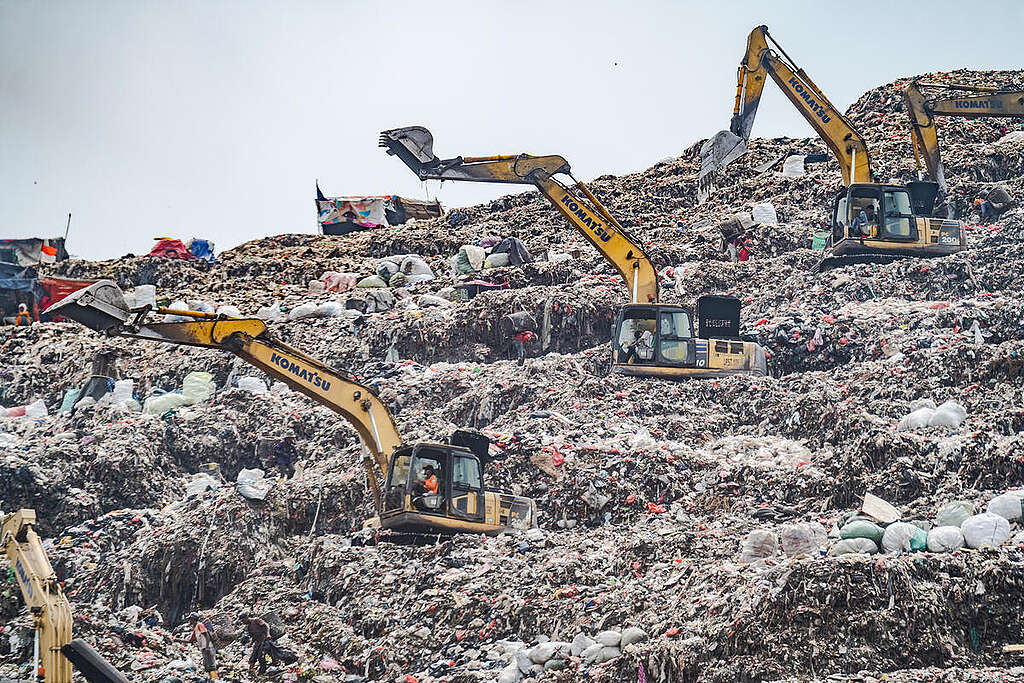
 Indonesia – Excavators work on the Bantargebang landfill in Bekasi, West Java, often described as the largest open-dumping landfill in Southeast Asia and one of the world’s biggest, serving Jakarta with massive daily waste intake and becoming a vast, populated waste mountain.
Indonesia – Excavators work on the Bantargebang landfill in Bekasi, West Java, often described as the largest open-dumping landfill in Southeast Asia and one of the world’s biggest, serving Jakarta with massive daily waste intake and becoming a vast, populated waste mountain.
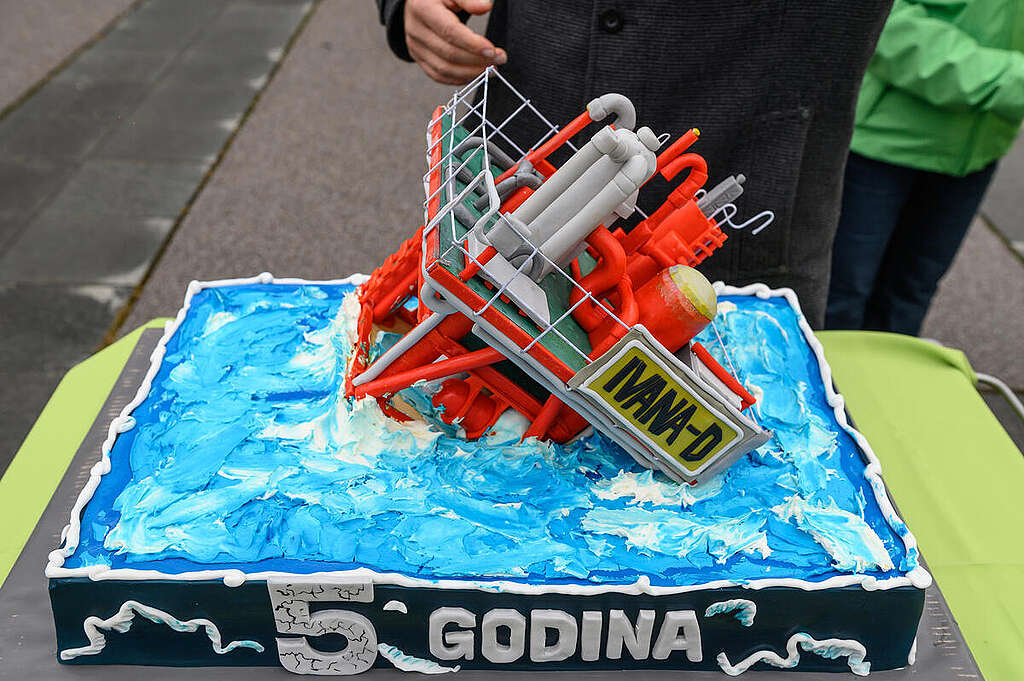
 Croatia – Greenpeace Croatia partnered with satirical activist Dario Juričan and held a performance protest in front of the fossil company Ina, on the 5-year anniversary since its gas platform Ivana D sank to the bottom of the Adriatic Sea. Activists prepared a cake with a model of a sunken platform on it as a present to congratulate the company. The company sadly declined to accept the cake.
Croatia – Greenpeace Croatia partnered with satirical activist Dario Juričan and held a performance protest in front of the fossil company Ina, on the 5-year anniversary since its gas platform Ivana D sank to the bottom of the Adriatic Sea. Activists prepared a cake with a model of a sunken platform on it as a present to congratulate the company. The company sadly declined to accept the cake.
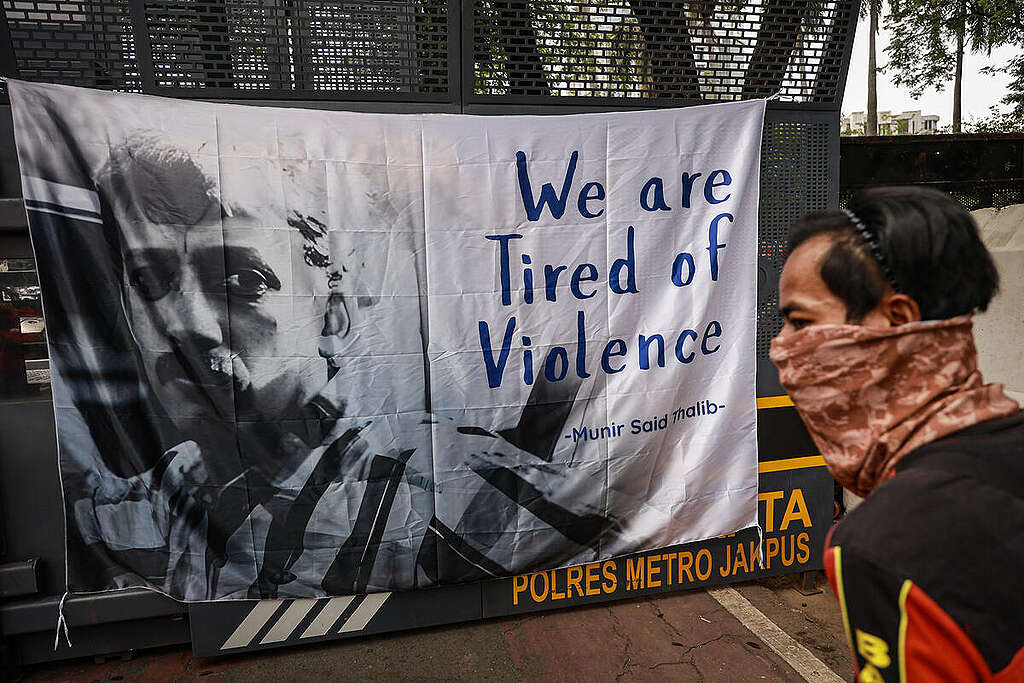
 Indonesia – Gerakan Buruh Bersama Rakyat (Gebrak) participates in the commemoration of Human Rights Day 2025, December 10th, in Jakarta. Greenpeace, along with a civil society coalition, urged the government to immediately declare a National Disaster Status for the crisis in Sumatra, halt all extractive projects that damage the environment, and undertake comprehensive reform of the police force to end impunity and the criminalisation of civilians.
Indonesia – Gerakan Buruh Bersama Rakyat (Gebrak) participates in the commemoration of Human Rights Day 2025, December 10th, in Jakarta. Greenpeace, along with a civil society coalition, urged the government to immediately declare a National Disaster Status for the crisis in Sumatra, halt all extractive projects that damage the environment, and undertake comprehensive reform of the police force to end impunity and the criminalisation of civilians.
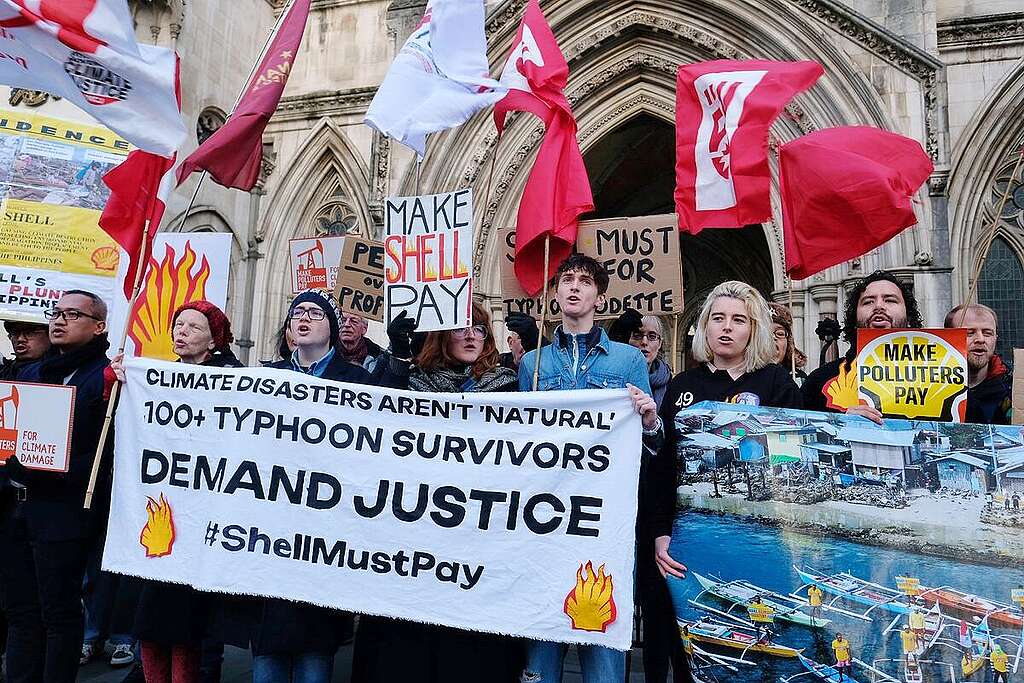
 U.K. – Activists from Fossil Free London, Greenpeace Philippines, Greenpeace UK, Uplift and members of the Filipino diaspora held a protest in support of climate survivors of Super Typhoon Odette (Rai) who have filed a civil case in a United Kingdom court (referred to as The Odette Case), taking a decisive step to hold oil giant Shell accountable for the deaths, injuries, and destruction left by the climate-fuelled storm, which hit the Philippines back in December 2021.
U.K. – Activists from Fossil Free London, Greenpeace Philippines, Greenpeace UK, Uplift and members of the Filipino diaspora held a protest in support of climate survivors of Super Typhoon Odette (Rai) who have filed a civil case in a United Kingdom court (referred to as The Odette Case), taking a decisive step to hold oil giant Shell accountable for the deaths, injuries, and destruction left by the climate-fuelled storm, which hit the Philippines back in December 2021.
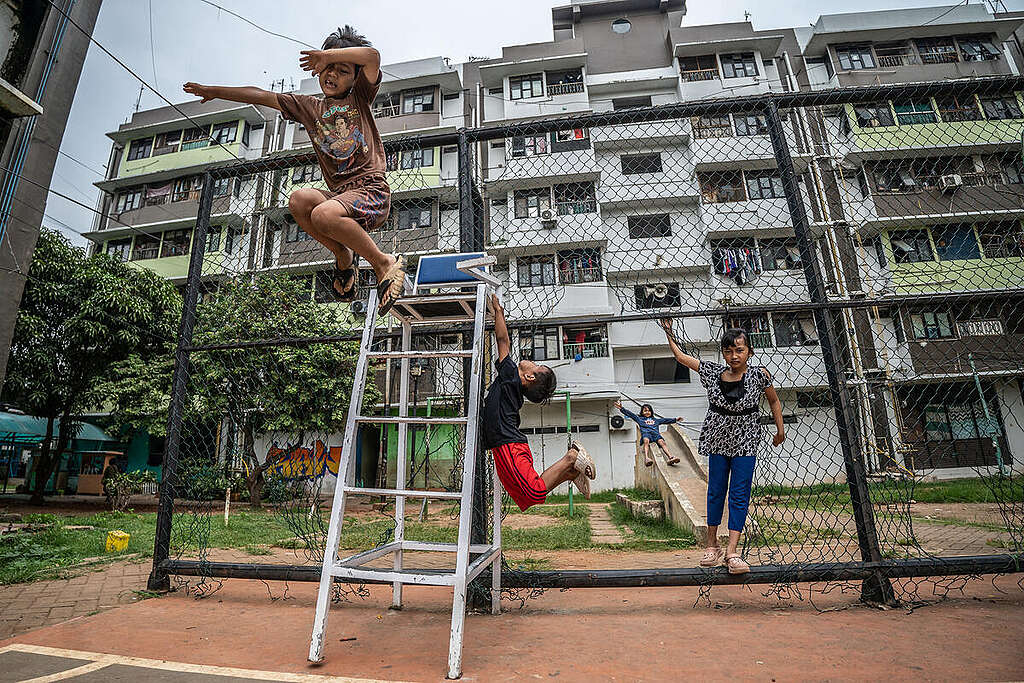
 Indonesia- Kids play on the playground at Marunda Flats Cluster A building in Marunda, North Jakarta. Residents of Marunda Flats are demanding the Jakarta government to provide an alternative and clean energy source, in which they have long been the victims of air pollution from the nearby coal-fired power plants and coal stockpiles.
Indonesia- Kids play on the playground at Marunda Flats Cluster A building in Marunda, North Jakarta. Residents of Marunda Flats are demanding the Jakarta government to provide an alternative and clean energy source, in which they have long been the victims of air pollution from the nearby coal-fired power plants and coal stockpiles.
Happy anniversary to the Paris Agreement? A 10-year review of climate action, setbacks and the fight to keep 1.5°C alive
Aaron Gray-Block
Ten years ago on 12 December 2015 in Paris at the UN climate conference COP21, a momentous agreement was reached, committing governments to efforts aimed at limiting global warming to 1.5°C. But 10 years later, the world is still dangerously off track from meeting the 1.5°C limit and much faster action to reduce fossil fuels emissions and end deforestation is needed. So what has the Paris Agreement achieved, what happens next and what is needed to limit climate change? The Paris Agreement gave the world a new direction and accelerated the clean energy transition, proving itself pivotal in lowering projected global greenhouse gas (GHG) emissions. This landmark accord has helped shape government policies and instigated multiple net-zero pledges from states and non-state (business) actors. The projected temperature increase has since fallen from just below 4°C at the time of adoption of the Paris Agreement to just below 3°C. There is still a large 1.5°C ambition gap, however, with current warming projections still well above the Paris Agreement’s goal. Consequently, the UN has warned in its latest Emissions Gap Report of a looming temporary exceedance – or overshoot in technical terms – of the 1.5°C limit, very likely within the next decade. This must become a rallying call for action, ensuring we limit this overshoot through faster and bigger reductions in GHG emissions to minimise future climate risks. Ahead of COP21 back in 2015, Greenpeace published the final version of its Energy [R]evolution scenario, showing that a highly efficient and 100% renewable energy system was not only possible, but absolutely necessary to prevent catastrophic warming. Our report was at that time considered a radical vision of possibility. That vision, however, is now becoming reality on the renewables front. Solar and wind power are now the most cost-effective forms of electricity generation, outperforming all other technologies in both cost and speed of installation. Since 2021, the International Energy Agency’s World Energy Outlook (WEO) has also included a ‘Net Zero Emissions by 2050 Scenario’ and in its 2025 WEO, the IEA said it still sees fossil-fuel use peaking before or around 2030, despite a recent surge in political support for coal, oil and gas. That same report affirmed that a renewable energy transition is underway and could solve the climate crisis along with other societal needs. Solar, wind and energy smart solutions are now clearly ready to deliver faster CO2 cuts than what countries currently assume in their pledged climate targets. Since 2010, the cost of solar, wind and batteries has respectively fallen by 90 percent, 70 percent and 90 percent, the IEA figures show, with further declines of 10-40 percent expected by 2035. The key now is for governments to speed up the transition by pushing fossil fuels out of the way and eliminating barriers related to grids, storage and climate finance gaps. But this must also be done as part of a just transition to ensure a fast, orderly and fair fossil fuel phase-out. During the UN climate conference COP30 in Belém, Brazil, in November, the UN published an aggregate analysis of countries’ 2035 climate action plans – known as Nationally Determined Contributions (NDCs) – and exposed again, however, an alarming lack of ambition. Under the Paris Agreement, countries are required to submit new, successively ambitious NDCs every five years to the UNFCCC secretariat. The updated 2025 Synthesis Report, however, showed that new 2035 NDCs will only produce a projected 12 percent cut in global emissions by 2035. This is woefully short of the 60 percent global reduction needed (compared to 2019 levels). The main culprits are the G20 countries, collectively responsible for 80 percent of global emissions. A Greenpeace report, the 2035 Climate Ambition Gap, found that G20 climate action plans would yield a paltry 23-29 percent cut in emissions towards the 60 percent global target. G20 countries are home to the world’s largest producers and consumers of fossil fuels, yet none of their 2035 NDCs include credible plans to phase them out. Their actions in the coming years will make or break the 1.5°C goal and it’s critical they ramp up ambition now. Above all, developed countries should be leading the way. The significance of the Paris Agreement cannot be overestimated. It was the first binding agreement that committed all nations together to combat climate change and adapt to its effects. It was adopted by 195 parties and entered into force on 4 November 2016. Despite efforts to undermine the accord by the US administration under President Trump – who has twice initiated a US withdrawal from the Paris Agreement – the Paris Agreement has withstood multiple challenges and been repeatedly affirmed by successive COPs. No other country has exited the Paris Agreement and at COP28 in Dubai, at the first Global Stocktake (GST) of action since the Paris Agreement, governments agreed for the first time to transition away from fossil fuels in a just, orderly and equitable manner and, secondly, to end deforestation by 2030. These GST decisions are like the bedrock of the Paris Agreement – clearly spelling out the foundational requirements to keep the 1.5°C limit in sight. A landmark advisory opinion in July from the International Court of Justice, also put countries on notice that they are legally obliged to protect the world from further warming, confirming that the Paris Agreement’s 1.5°C limit is the legal binding temperature threshold. Despite these achievements, is the Paris Agreement doing enough? The answer is still no. Among many pressing demands, more money for climate action, adaptation and loss and damage is urgently needed and Greenpeece is calling for countries to start making oil and gas companies pay for climate damages through a Polluters Pay Pact and campaigning for an end to deforestation. Greenpeace France activists also marked the Paris Agreement anniversary with a protest denouncing, among others, French President Macron and US President Trump for “10 years of climate sabotage”. It’s time that political and business leaders around the world finally stand with the millions of people demanding climate and biodiversity action. So, 10 years after the Paris Agreement, all eyes were on COP30 in Belém, where it was hoped that historic progress to phase out fossil fuels and end forest destruction would be achieved. The reality proved otherwise, where geopolitical divisions saw a call by the Brazil presidency for the adoption of roadmaps to end our dependence on fossil fuels and to end deforestation were slashed from the formal COP30 outcome. This result again showcased the disconnection between COPs and people calling for action. On the positive side though, more than 80 countries from the EU to Latin America and the Pacific were supportive of a roadmap to transition away from fossil fuels and more than 90 countries were ready to back a deforestation roadmap. And Brazil committed to a Presidency-led initiative to take forward the roadmaps in 2026, reporting to COP31. The fossil fuel roadmap might have been blocked this time, but nothing can erase the fact that a roadmap is now the expectation from a large and growing group of countries, not a radical idea. That demand isn’t going away and it has now created a clear benchmark for future action. Moving forward from COP30, we must maintain momentum for both of these roadmaps and reinforce initiatives from these ‘coalitions of the willing’ to drive actionable results at the next COPs and to ultimately achieve the 1.5°C limit anchored in the Paris Agreement. Together we can resist, rise and renew! Texte intégral (2489 mots)
The global temperature trajectory is falling
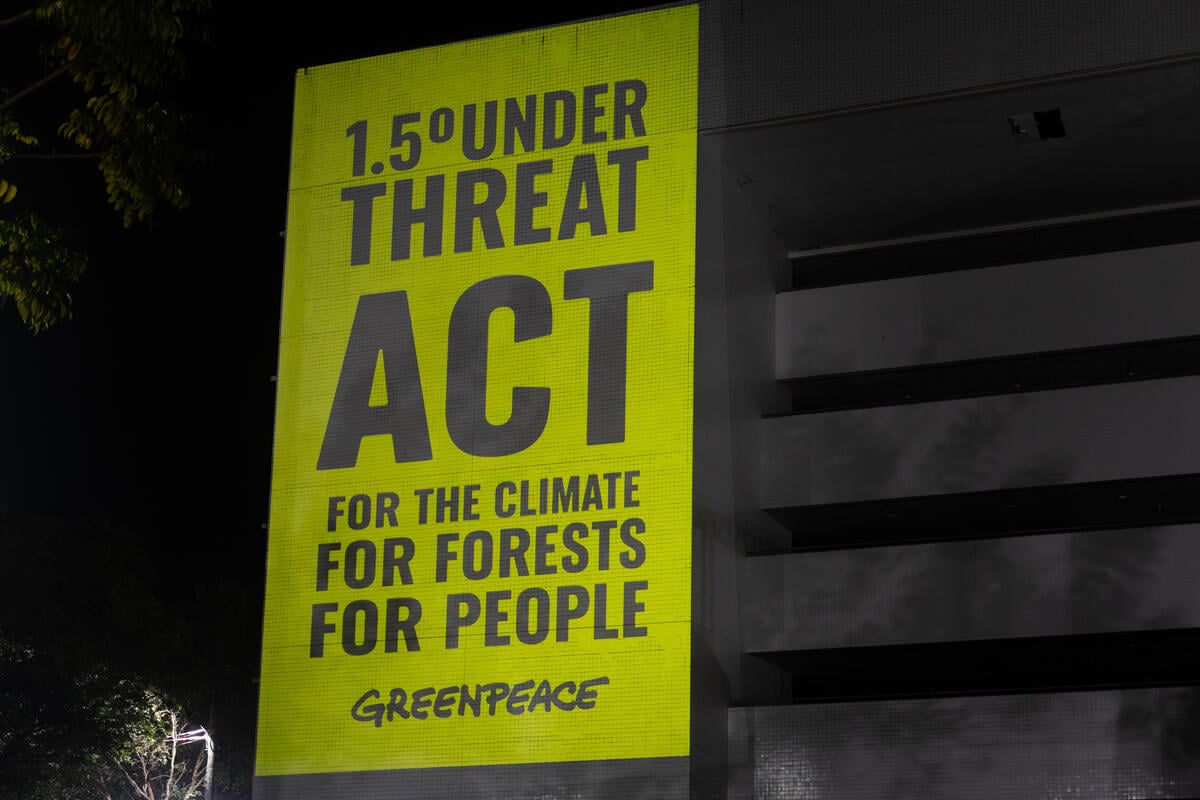

Ambitious energy futures have become the mainstream
Climate action plans are still insufficient
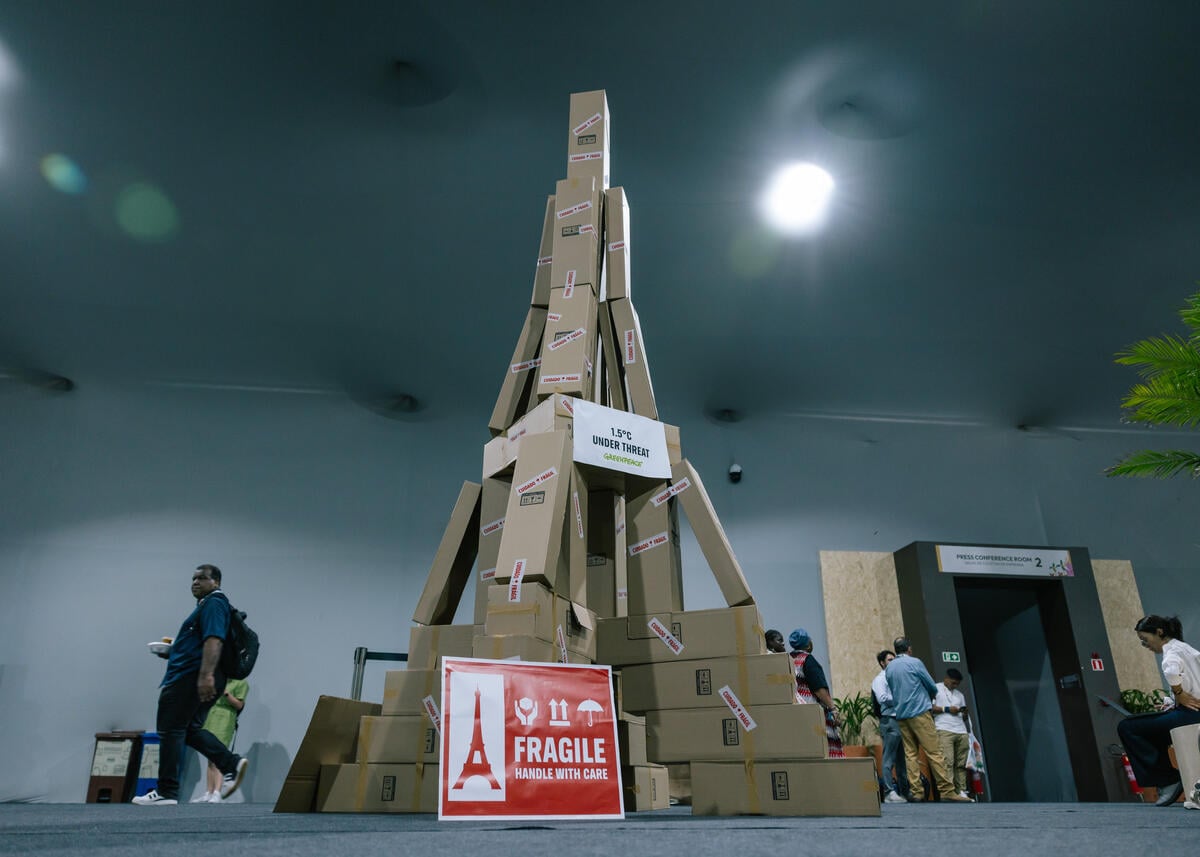
Paris Agreement a shining, resilient light of global climate politics
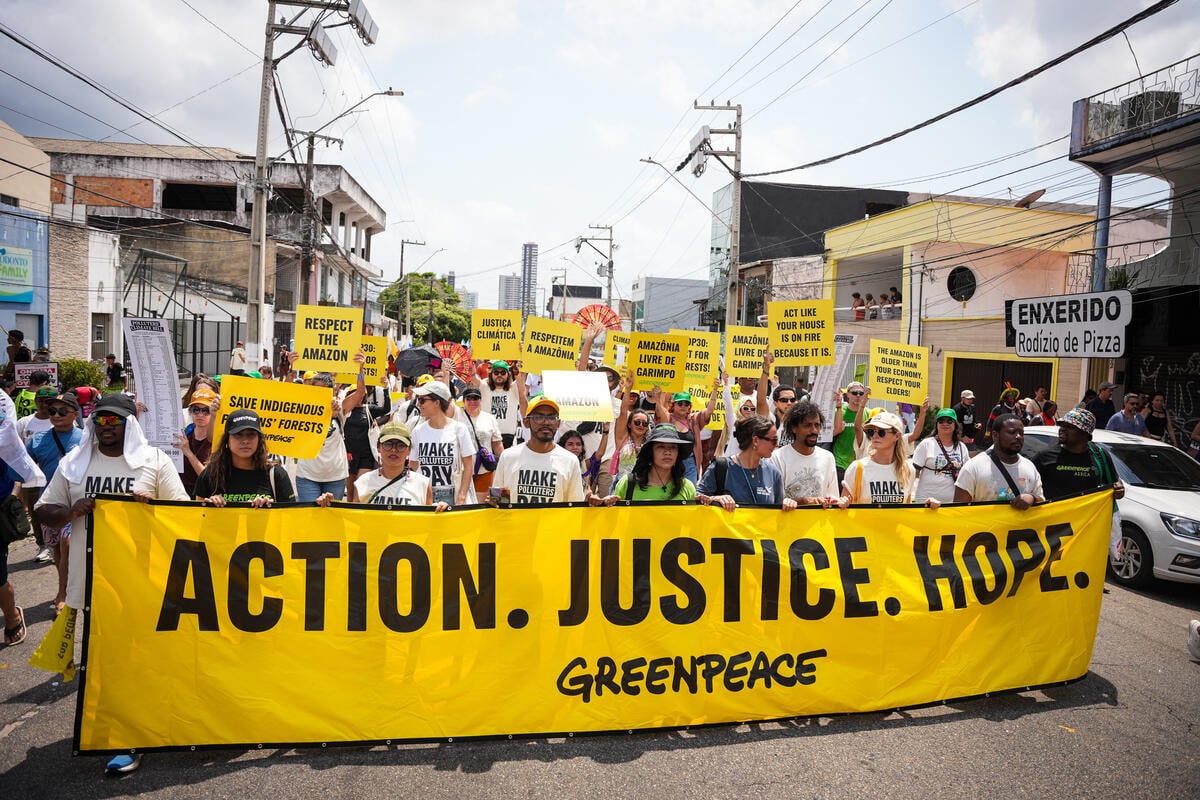
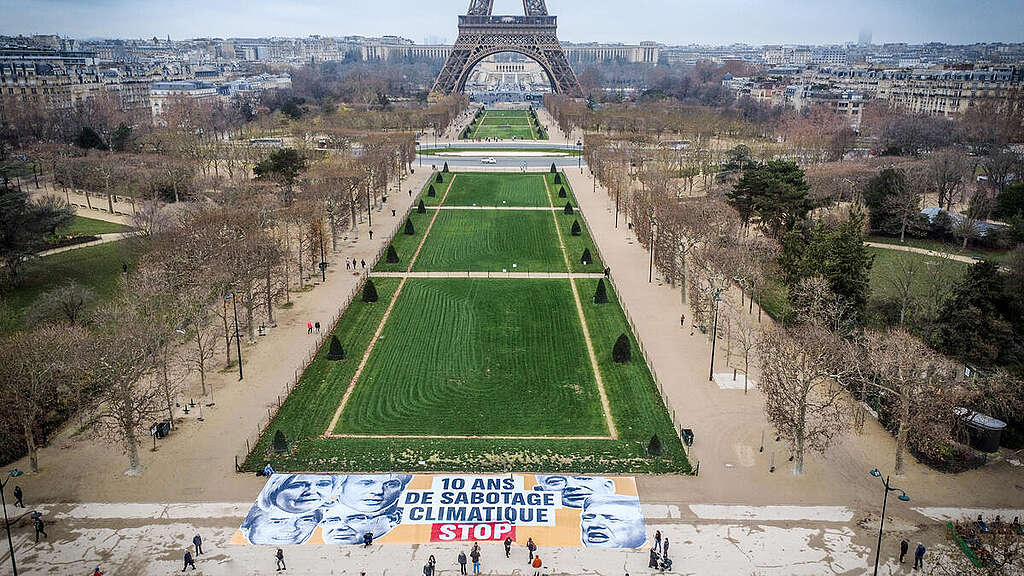
At COP30, roadmaps to end fossil fuels and deforestation were on the agenda
‘10 years of climate sabotage’: activists denounce Macron, Trump to mark Paris Agreement anniversary
Greenpeace International
Paris, France – Greenpeace France and French activist networks ANV-COP21 and Action Justice Climat have displayed a giant banner in front of the Eiffel Tower denouncing, among others, French President Macron and US President Trump for sabotaging climate action in an activity on the eve of the 10th anniversary of the Paris Agreement. The 300 square metre banner featured the faces of both Macron and Trump, and also French far-right politician Marine Le Pen, French billionaire businessman Vincent Bolloré, TotalEnergies CEO Patrick Pouyanné and US billionaire Jeff Bezos. On the banner, written in French, were the words: ‘10 years of climate sabotage’ and the word ‘Stop’ to demand an end to climate sabotage. Photos of the activity can be found in the Greenpeace Media Library. Sarah Fayolle, Climate Campaign Manager, Greenpeace France said: “These are just some of the faces of climate sabotage. Ten years after the Paris Agreement, our climate is at risk of spiraling out of control due to the weakness and irresponsibility of political decision makers. They have sold our future safety to powerful private interests at the expense of social and climate justice, endangering us all. We must resist and rise up!” The Paris Agreement was adopted on 12 December 2015 in the French capital at the UN climate conference COP21, committing the world’s governments to limiting global warming to 1.5°C. Ten years later and on the eve of COP30 in Belém, Brazil, last month, the UN warned it is very likely the 1.5°C threshold will be exceeded, at least temporarily, within the next decade.[1] The UN Emissions Gap Report 2025 predicted global temperatures to reach 2.3-2.5°C by the end of the century. Since the adoption of the Paris Agreement, temperature predictions have fallen from 3-3.5°C, but faster action is urgently required. Jasper Inventor, Deputy Programme Director, Greenpeace International said: “We must face the reality that 2035 climate action plans are dangerously off track and the 1.5°C limit is not just under threat, it’s almost gone. Governments must urgently confront this truth and take rapid action to bridge the ambition gap. That means holding polluters to account by making them pay, ending deforestation and accelerating the transition away from fossil fuels.” Thursday’s action was carried out with French activist networks Action Justice Climat and ANV-COP21. The faces depicted on the banner symbolise the political and business forces undermining the fight against climate change. But despite these actors, millions around the world are mobilising and demanding change. Zoé Pelegry, spokesperson, ANV-COP21 said: “From politicians to the CEOs of oil and gas companies and billionaires laughing all the way to the bank, these are the faces that represent the injustice of our extractive-based economy that puts profit first and people and planet last. But we will not give up and with millions of people around the world we’ll continue with our actions to show that other paths exist in the face of climate sabotage!” Léa Geindreau, spokeperson, Action Justice Climat Paris said: “Each of the faces depicted on the banner embodies a form of climate sabotage: from Trump’s ‘drill, baby, drill’ mentality to Macron’s climate cynicism or the climate disinformation orchestrated by private actors like Vincent Bolloré. Each of them, in their own way, are derailing climate action.” The banner also featured the face of Patrick Pouyanné, head of the oil and gas major TotalEnergies, a leading force in the global expansion of fossil fuels. Jeff Bezos represents the billionaires whose lifestyles and investments fuel the climate crisis, while Marine Le Pen embodies the French far right and its threat to climate action and social justice. ENDS Photos available in the Greenpeace Media Library. Notes: [1] UNEP Emissions Gap Report 2025 Contacts: A press conference “Climate: Listening to Other Voices,” highlighting the perspectives of those on the front lines of the climate crisis, will be held on December 12 at 8:45 am at Greenpeace France headquarters, 13 rue d’Enghien, 75010 Paris. This press conference can also be followed via video conference. To register, contact Franck Mithieux at Greenpeace France by email: franck.mithieux@greenpeace.org Greenpeace International Press Desk, +31 (0)20 718 2470 (available 24 hours), pressdesk.int@greenpeace.org Texte intégral (794 mots)
Filipino communities to sue Shell for Super Typhoon Rai damage in world first
Greenpeace International
London/Quezon City – Survivors of Super Typhoon Rai – locally known as Odette – in the Philippines are suing Shell Plc for propelling the climate catastrophe with knowledge of the risks, in the first major transnational lawsuit seeking personal and property damages from an oil and gas company. The case, the first civil claim to also directly link the climate impacts of oil and gas companies to deaths and personal injury already suffered in the Global South, will be heard in the United Kingdom under Philippines law, and is being brought on behalf of over 100 Filipinos who lost loved ones, homes, or suffered serious injuries when Rai struck in December 2021.[1] Greenpeace Philippines Climate Campaigner Jefferson Chua said, “We’re seeing a surge of climate cases led by Global South communities – a clear sign that people will no longer let oil and gas giants like Shell profit while those who contributed least to this crisis bear the heaviest costs.” “Odette survivors are showing extraordinary courage by demanding accountability from one of the world’s biggest climate polluters. They are seeking justice for what they have endured and fighting to protect our collective future. Shell must answer for its part in fueling the extreme weather that devastates their communities.” The case draws on new climate attribution research which found that human-induced climate change more than doubled the likelihood of an extreme weather event like Typhoon Rai.[2] According to government authorities, Super Typhoon Odette killed more than 405 people in the Philippines, injured around 1,400, and cost the Philippines more than US$700 million in damage.[3] The survivors argue that Shell’s historic carbon pollution worsened disasters like Super Typhoon Odette and are seeking compensation for the harm suffered from the typhoon. It is the first civil case to directly link an oil major’s polluting actions to deaths and injuries from climate impacts in the Global South. Survivors contend that Shell — responsible for over 41 billion tonnes of CO₂e , or more than 2% of global fossil fuel emissions, according to the Carbon Majors database — cannot claim ignorance.[4] Even after Odette, the company scaled back climate commitments and expanded oil and gas investments, contradicting clear scientific guidance that no new fossil fuel development is compatible with a liveable future.[5] This comes on top of a long history of industry disinformation and lobbying that delayed climate action.[6] For survivors, Shell’s recent decisions show that despite understanding the risks, Shell continued to expand its fossil fuel operations. Shell raked in record profits of US$40 billion the year after Odette, and the company’s latest full-year profit was recorded at US$16.5 billion.[5] Trixy Elle, one of the claimants in the case, said in Filipino, “Suing a big corporation like Shell for their role in worsening Typhoon Rai might be a tall task, but I have to think about my children’s future.”[6] “That’s where I get my motivation to go on with the case. It’s so unfair that we have to suffer the effects of climate change even if our contribution to global pollution is so minuscule compared to Shell. Why is it that we have to shoulder the burden?” This community-led legal action comes on the heels of the International Court of Justice Advisory Opinion in respect of climate change (ICJAO), confirming that states must regulate businesses for climate harms caused by their emissions, regardless of where the harm occurs and builds upon the landmark investigation by the Philippines Commission on Human Rights on the corporate responsibility of the climate crisis of 2015-2022.[7][8] The Odette survivors’ case is both a call for climate justice and systemic accountability: to make polluters pay, and reclaim the Filipino people’s right to a balanced and healthy ecology. ENDS Photos can be accessed from the Greenpeace Media Library Notes: [1] Consistent with well-established legal principles, the case will be brought in the UK courts, where the defendant is domiciled, and apply the law of the Philippines, where the harm occurred. As the case relates to actions taken by a UK-domiciled company in the UK and/or throughout their global operations rather than operations of their subsidiaries in the Philippines, the UK is the only proper legal forum for this case. While the case will be taken in the UK courts, the law applicable to the case is the law of the Philippines, according to the provisions of the Rome II Regulation, 7 as this is the country in which the damage occurred. [2] The influence of anthropogenic climate change on Super Typhoon Odette (Typhoon Rai) and its impacts in the Philippines [3] https://monitoring-dashboard.ndrrmc.gov.ph/assets/uploads/situations/Infographics_Odette.pdf [5] Annual Report and Accounts 2024 | Shell Global [6] Translation by Greenpeace Philippines [7] Obligations of States in respect of Climate Change [8] The Climate Change & Human Rights Inquiry Archive – Greenpeace Philippines Contacts: Karl Isaac Santos, Communications Team, Greenpeace Philippines, +63 917 675 8883, socmedph@greenpeace.org Atty. Ryan Roset, Legal Rights and Natural Resources Center (LRC), mythrandrir@gmail.com Texte intégral (953 mots)
Cook Islands deep sea mining nodule extraction has high risk of economic losses – independent study
Greenpeace International
Amsterdam, Netherlands – The economic potential of seabed polymetallic nodules in the South Pacific’s Cook Islands has been overstated, according to a new independent study commissioned by Greenpeace International.[1] Once costs, market factors, and technological challenges are accounted for, deep sea mining for Cook Islands nodules is more likely to incur an economic loss, the analysis indicates. Juressa Lee, Campaigner, Greenpeace Aotearoa, said: “Deep sea mining companies that have made bold claims to try and win social licence in places like the Cook Islands are now being exposed — their sales pitch simply doesn’t add up. Scientific warnings are crystal clear: deep sea mining will damage the oceans and harm biodiversity. Millions of people across the world, including people in the Cook Islands, are concerned about the threats posed by this industry. When you add the major financial risks, it’s hard to understand why anyone is still pushing this industry at all.” Polymetallic nodules are metal-rich rocks that sit on the deep seafloor, increasingly targeted by mining companies despite scientists’ warnings of severe ecological damage. [2] The new report highlights several reasons why the promise of these “golden apples” — as Cook Islands Prime Minister Mark Brown described the nodules — does not hold up. The author finds that the technologies required to extract the nodules have not been commercially demonstrated, noting that operating “at depths three times greater than the Deepwater Horizon and >15 times deeper than North Sea oil, pose significant challenges to reliable operation”. According to the author, the estimated operating costs at such depths are on a par with, or higher than, their expected market value, making commercial operations unviable. According to this expert’s assessment, there are no single processing facilities worldwide capable of converting raw nodules into saleable metals, and building new plants and supply chains would involve major technical and financial risks. Market outlook is weakest for cobalt and manganese, the primary components of value in Cook Islands nodules. The expert finds Cook Islands nodules’ estimated market value is only US$100–140 per dry tonne, far below the level needed to support a profitable industry. ‘The release of the study comes as the deep sea mining frontrunner, Belgium’s Global Sea Mineral Resources (GSR)announces its plan to divest its interests in the Cook Islands and refocus on activities in the Clarion-Clipperton Zone (CCZ). GSR intends to sell its share of the joint venture company Cobalt Seabed Resources (CSR), which was established to pursue mining in the Cook Islands. Although no buyer has been officially named, local reporting has pointed to speculation about a possible sale to American company Wetstone, a newly formed company with little public track record and who seems close to former International Seabed Authority Secretary General, Michael Lodge.[3][4][5] The future of Pacific Island nations is inextricably linked to healthy oceans — yet this future is now at risk from proposals to open the deep sea to mining, whether within national waters or in international waters. The Pacific Ocean, and the livelihoods it sustains, must be protected. Greenpeace urges coordinated action from Pacific Island governments to safeguard their own waters by putting a ban on deep sea mining, while a global moratorium at the International Seabed Authority is needed to defend the world’s largest ocean commons. ENDS Notes: [1] Link to report: Economic Potential of Seabed Manganese Nodules in the Cook Islands The Author: Lyle Trytten is a chemical engineer and metallurgical consultant with over three decades of global experience in sustainable battery metals, spanning R&D, project development, operations, and lifecycle and techno-economic assessments across nickel, cobalt, copper, lithium, and graphite. His expertise has been featured in The Elements of Deep Sea Mining, the Redefining Energy – Tech podcast series, and major media outlets including Bloomberg, Time, The Economist, and The Wall Street Journal. He has also informed national and international agencies and contributed to the analytical foundation of the recent RAND Corporation report on seabed mining. [2] Study measuring the impacts of a deep-sea mining machine finds the abundance of animals at the site decreased by 37%. Study measuring the impacts of a deep-sea mining machine finds the abundance of animals at the site decreased by 37% | Natural History Museum [3] GSR and the Cook Islands Investment Corporation (CIIC) hold exploration rights through their joint venture, Cobalt Seabed Resources Ltd, but GSR has confirmed it is withdrawing from its Cook Islands interests. GSR Announces Strategic Review of Its Seabed Mineral Interests to Advance Priority Initiatives in the CCZ – GSR [4] GSR is potentially selling to Wetstone. Te Ipukarea Society: Questions mount as mining company exits Cook Islands – Cook Islands News [5] U.S. federal agency clears ways for deep-sea mining — and companies are lining up Contacts: Texte intégral (1026 mots)
Juressa Lee, Campaigner, Greenpeace Aotearoa said: “Resistance to seabed mining in the Cook Islands and across the Pacific is strong and persistent. Pacific Peoples will not be sidelined by corporations and powerful countries trying to impose this new form of extractive colonialism on the region. Alongside our allies, who want to protect the ocean for future generations, we will continue to resist wannabe miners who want to strip the seafloor, causing irreversible harm for profits that are clearly far from guaranteed.”
Sol Gosetti, Global Media Coordinator, Stop Deep Sea Mining campaign, Greenpeace International, WhatsApp +44 (0) 7380845754, sol.gosetti@greenpeace.org
Greenpeace International Press Desk, +31 (0) 20 718 2470 (available 24 hours), pressdesk.int@greenpeace.org
Greenpeace Pictures of the Week
Greenpeace International
From Black Friday to COP30, here are a few highlights of Greenpeace work around the world in the past seven days. Greenpeace has been a pioneer of photo activism for more than 50 years, and remains committed to bearing witness and exposing environmental injustice through the images we capture. To see more Greenpeace photos and videos, visit our Media Library. Texte intégral (1840 mots)
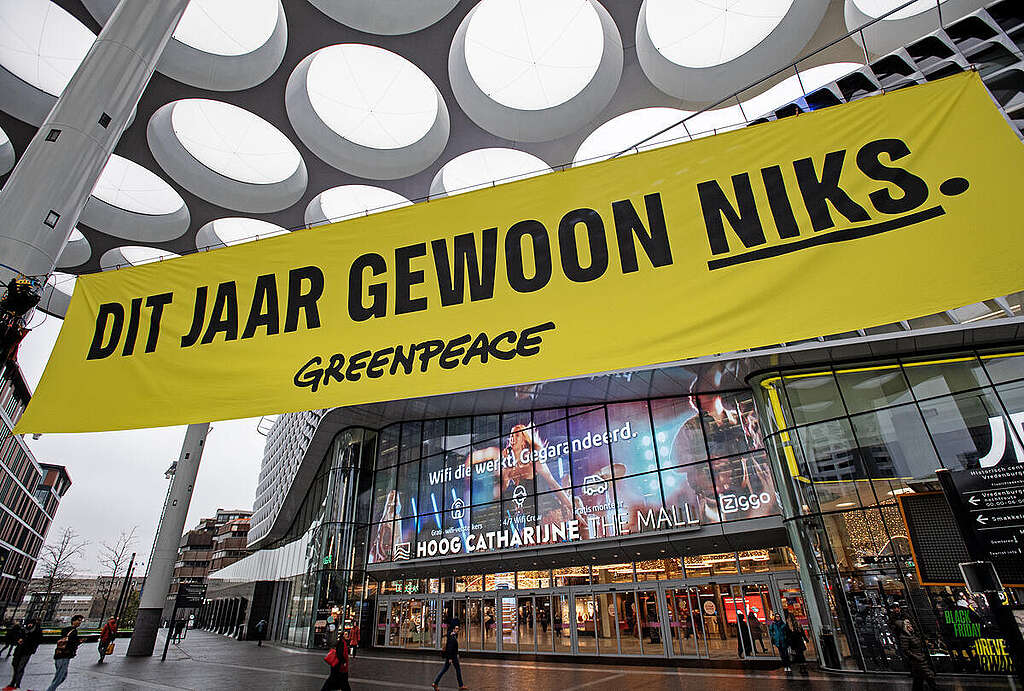
 Netherlands – Greenpeace climbers hang a banner at the entrance of Hoog Catharijne shopping mall, beneath the iconic domed roof at Utrecht Central Station, reading “THIS YEAR, JUST NOTHING” to draw attention to the impact of overconsumption around Black Friday.
Netherlands – Greenpeace climbers hang a banner at the entrance of Hoog Catharijne shopping mall, beneath the iconic domed roof at Utrecht Central Station, reading “THIS YEAR, JUST NOTHING” to draw attention to the impact of overconsumption around Black Friday.
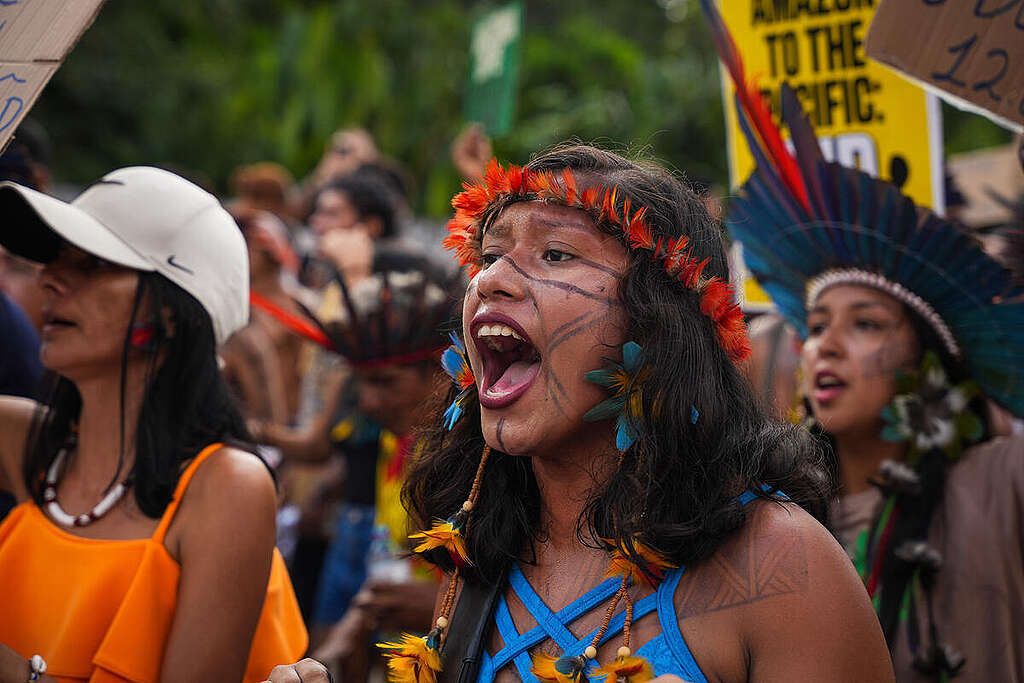
 Brazil – Organized by the Articulation of Indigenous Peoples of Brazil (APIB), a huge march brought together Indigenous people and activists in the streets of Belém, the host city of COP30. Carrying the message “We Are the Answer,” the demonstration marked “Indigenous Peoples’ Day at COP30,” promoting climate debate and the defence of the rights and territories of Indigenous peoples.
Brazil – Organized by the Articulation of Indigenous Peoples of Brazil (APIB), a huge march brought together Indigenous people and activists in the streets of Belém, the host city of COP30. Carrying the message “We Are the Answer,” the demonstration marked “Indigenous Peoples’ Day at COP30,” promoting climate debate and the defence of the rights and territories of Indigenous peoples.
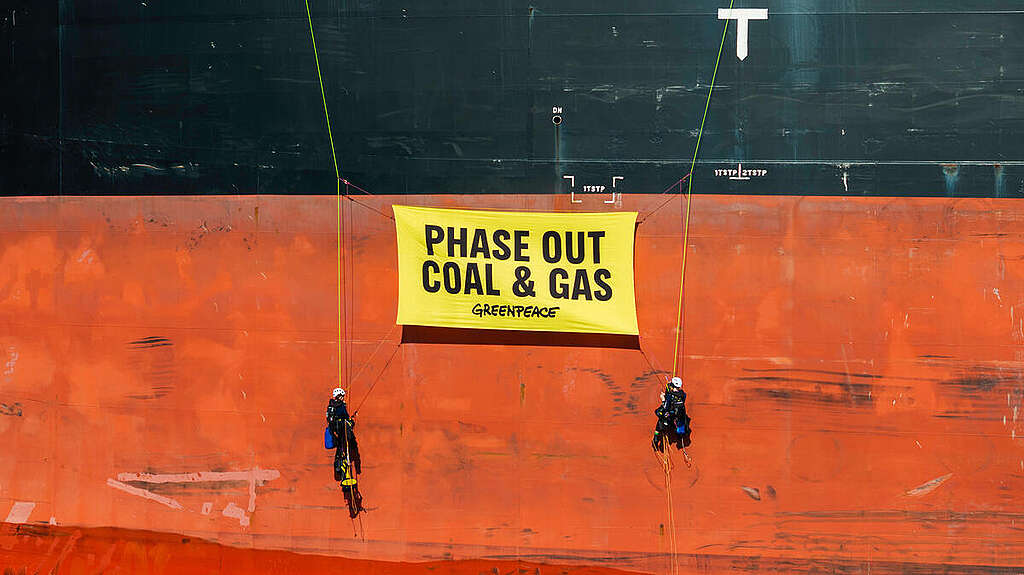
 Australia – Greenpeace Australia Pacific activists have scaled and blocked the coal ship Yangze 16, bound for the world’s largest coal port, the Port of Newcastle, during the Rising Tide People’s Blockade, deploying a banner with a message to the Australian government: “Phase Out Coal and Gas”.
Australia – Greenpeace Australia Pacific activists have scaled and blocked the coal ship Yangze 16, bound for the world’s largest coal port, the Port of Newcastle, during the Rising Tide People’s Blockade, deploying a banner with a message to the Australian government: “Phase Out Coal and Gas”.
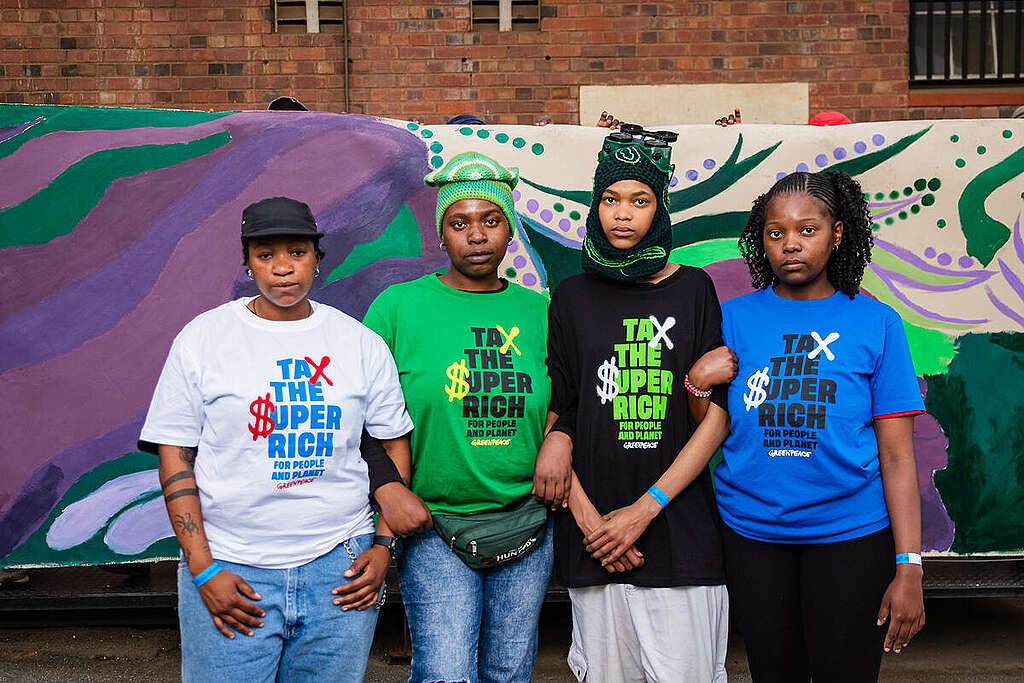
 South Africa – Greenpeace Africa activists sent message to world leaders from Johannesburg’s Constitution Hill: #TaxTheSuperRich for people and planet! Activists are gathered at the ‘We the 99’ People’s Summit ahead of the G20.
South Africa – Greenpeace Africa activists sent message to world leaders from Johannesburg’s Constitution Hill: #TaxTheSuperRich for people and planet! Activists are gathered at the ‘We the 99’ People’s Summit ahead of the G20.
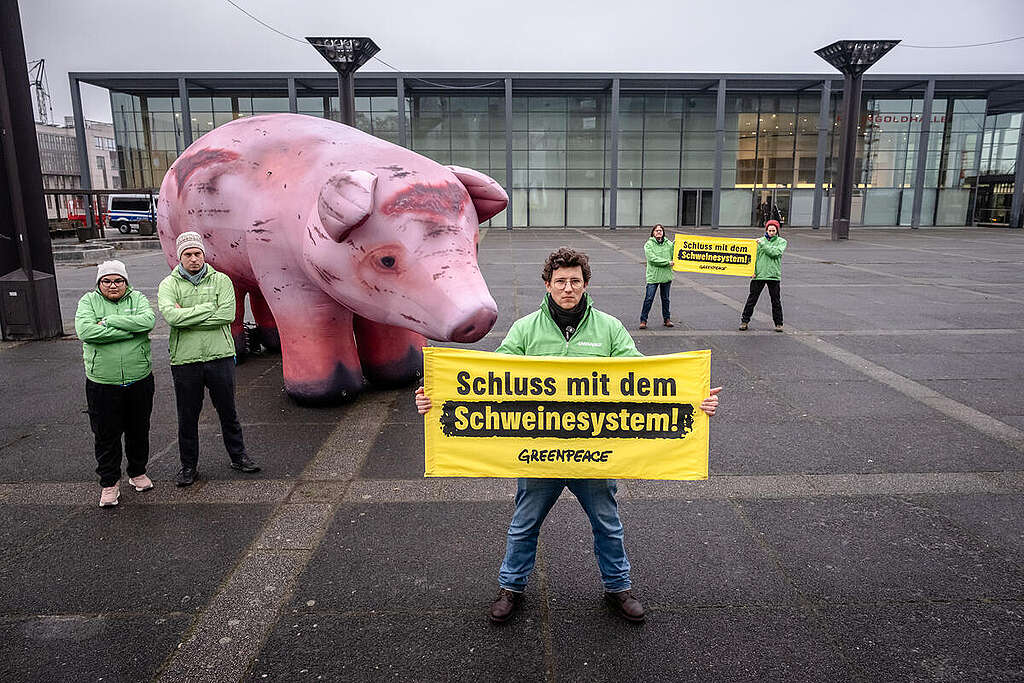
 Germany – Greenpeace activists protest for a change in the meat industry at the German meat congress in Mainz, away from a climate-damaging and animal-cruel, cheap-meat production.
Germany – Greenpeace activists protest for a change in the meat industry at the German meat congress in Mainz, away from a climate-damaging and animal-cruel, cheap-meat production.
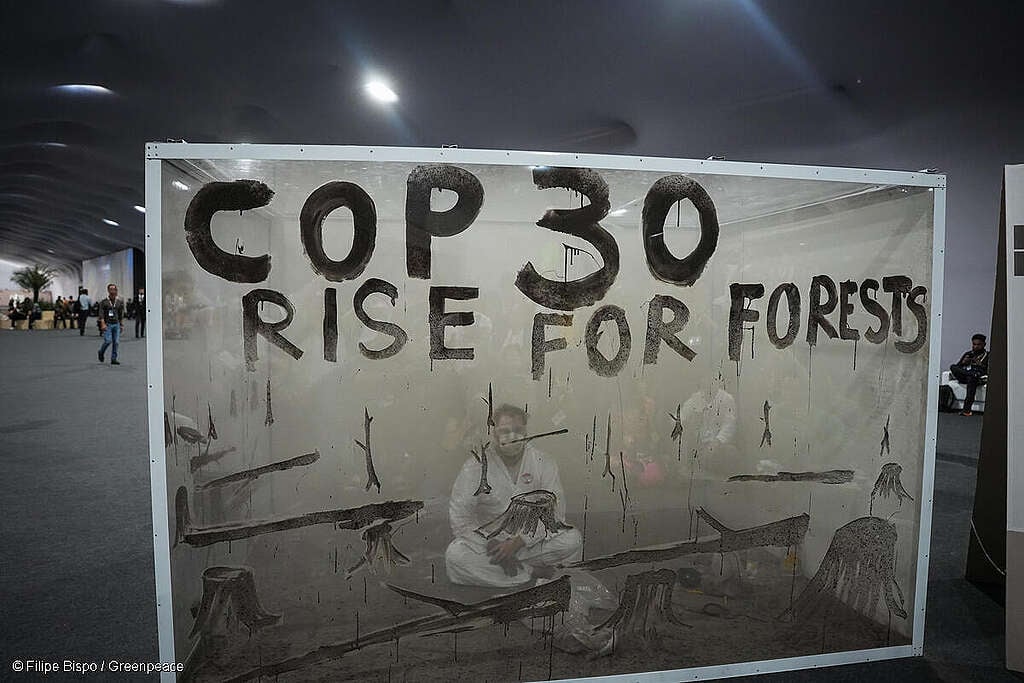
 Brazil – Brazilian artivist Mundano delivered, in partnership with Greenpeace a striking art installation to demand world leaders take bold action for forests at COP30. Mundano wrote the message “COP30: Rise for Forests” with transparent ink, and used ashes taken from forest fires in the Amazon to reveal the text.
Brazil – Brazilian artivist Mundano delivered, in partnership with Greenpeace a striking art installation to demand world leaders take bold action for forests at COP30. Mundano wrote the message “COP30: Rise for Forests” with transparent ink, and used ashes taken from forest fires in the Amazon to reveal the text.
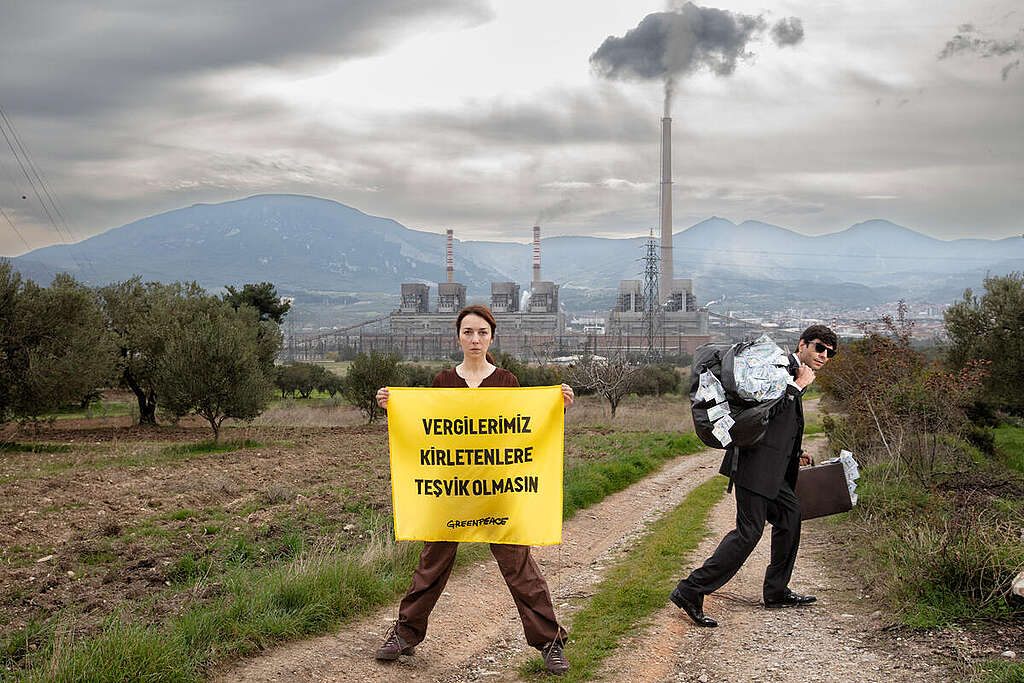
 Turkey – The budget discussions of the Ministry of Environment, Urbanisation and Climate Change began on 27 November. Greenpeace Türkey is calling for the budget to include measures ensuring tax and climate justice, drawing attention to the subsidies provided for fossil fuels in front of the Soma Coal Power Plant.
Turkey – The budget discussions of the Ministry of Environment, Urbanisation and Climate Change began on 27 November. Greenpeace Türkey is calling for the budget to include measures ensuring tax and climate justice, drawing attention to the subsidies provided for fossil fuels in front of the Soma Coal Power Plant.
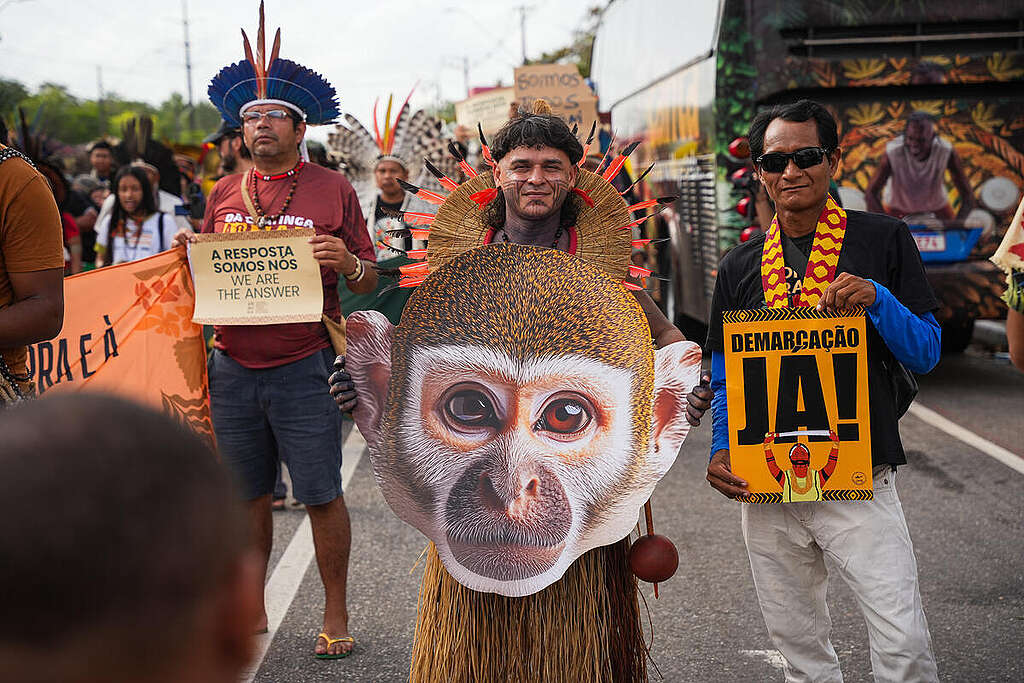
 Brazil – Organized by the Articulation of Indigenous Peoples of Brazil (APIB), a huge march brought together Indigenous people and activists in the streets of Belém, the host city of COP30. Carrying the message “We Are the Answer,” the demonstration marked “Indigenous Peoples’ Day at COP30,” promoting climate debate and the defence of the rights and territories of Indigenous peoples.
Brazil – Organized by the Articulation of Indigenous Peoples of Brazil (APIB), a huge march brought together Indigenous people and activists in the streets of Belém, the host city of COP30. Carrying the message “We Are the Answer,” the demonstration marked “Indigenous Peoples’ Day at COP30,” promoting climate debate and the defence of the rights and territories of Indigenous peoples.
Bon Pote
Actu-Environnement
Amis de la Terre
Aspas
Biodiversité-sous-nos-pieds
Bloom
Canopée
Décroissance (la)
Deep Green Resistance
Déroute des routes
Faîte et Racines
Fracas
F.N.E (AURA)
Greenpeace Fr
JNE
La Relève et la Peste
La Terre
Le Lierre
Le Sauvage
Low-Tech Mag.
Motus & Langue pendue
Mountain Wilderness
Negawatt
Observatoire de l'Anthropocène
